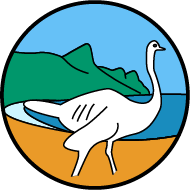
Ostrich Trails
Because it is a walking bird and walking is what we do.
- Nuremberg Walking Tour
Home » Europe » Germany » Nuremberg Walking Tour
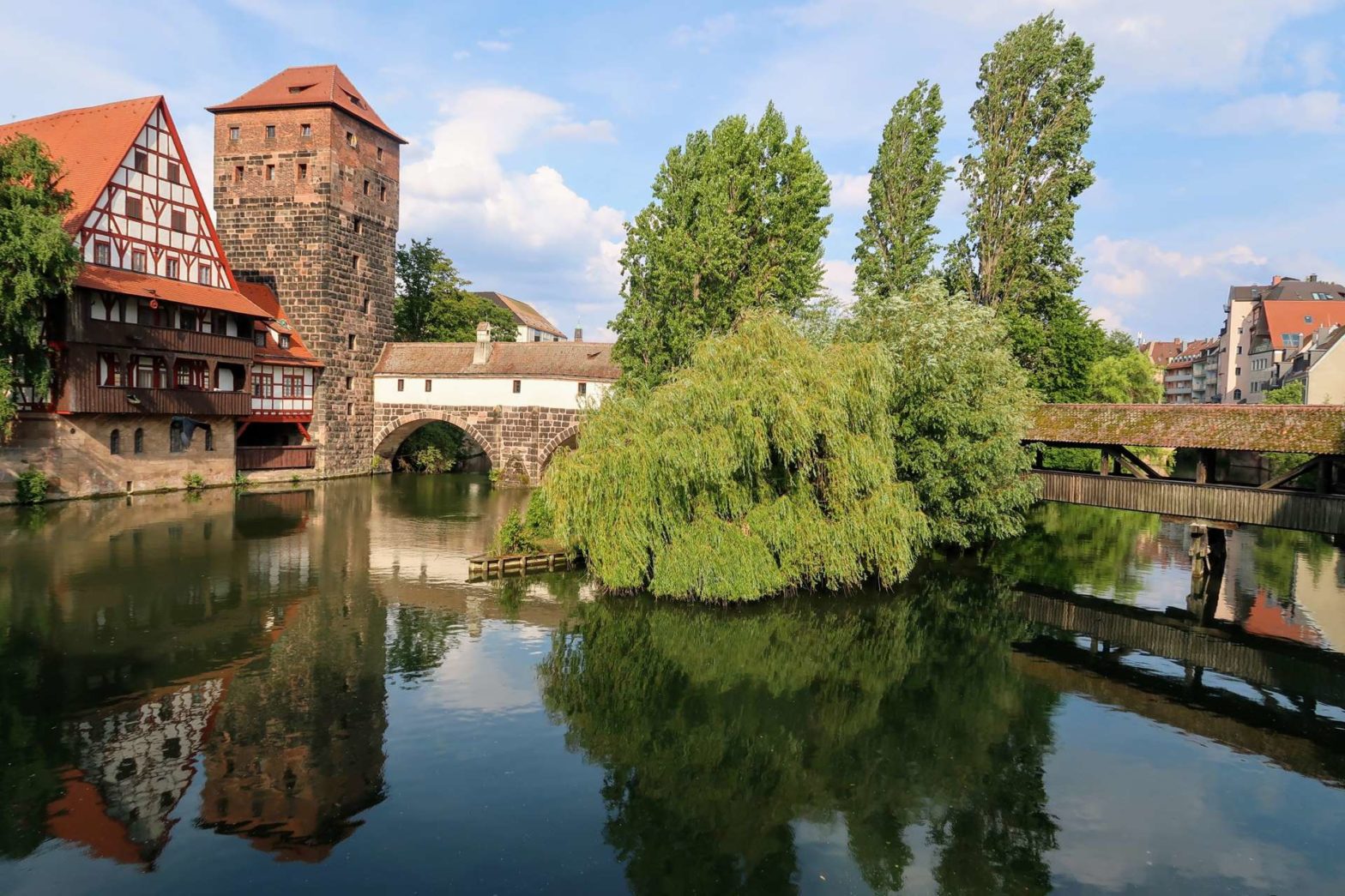
By Vicky · Published Jul. 25th, 2022 · Updated Dec. 18th, 2023
When you buy through links highlighted with an asterisk (*) on this site, we may earn a small affiliate commission at no cost to you.
A Walking Tour of Nuremberg (Nürnberg) is the best way to explore this delightful historical city in Bavaria. Discover half-timbered houses, many museums, the famous Nuremberg Trials and the home of Albrecht Dürer. This is a free self-guided walking tour, but if you prefer, check out this great guided tour of Nuremberg *.
Page Contents:
This walk starts from Nuremberg train station . It’s 1hr20-1hr50 minutes on the train from Augsburg and 1hr-2hrs from Munich. It’s slightly longer if you decide to drive.

Nuremberg Self-Guided Walking Tour Map
Get the route by downloading the .gpx or .kml file below. For navigation with Maps.me on your mobile phone, simply download the .kml file and open to add it to the Maps.me bookmarks.
Tips for Nuremberg Walking Tour
- The Nuremberg City Museums are €6 each, or 9 for a day pass that lets you visit all of them. These include: the Documentationzentrum, the Memorial Nuremberg Trials, Albrecht Dürer Haus, and the Stadtmuseum Fembohaus.
- There’s a famous Christmas market here (from late November to Christmas Eve).
- This walking tour lasts 2-5 hours depending on how long you spend in the museums.
- Why not also explore the cute town of Donauwörth , less than an hour away from Nuremberg on the train.
- Check out other walks on our Germany Hiking Page .
Top Sights in Nuremberg
On this self-guided walking tour you’ll see the main sites and attractions of Nuremberg. One to two days is the perfect amount of time to spend in Nuremberg .
- St Lorenz Church
- Hauptmarkt & Frauenkirche
- Altes Rathaus & Medieval Dungeons
- St Sebaldus Church
- Stadtmuseum Fembohaus
Albrecht Dürer Haus
- Historischer Kunstbunker
- Felsengänge
- Pegnitz River Views
- Weisser Turm Square
- Germanisches Nationalmuseum
This walking tour of Nuremberg is self-guided and free. If you prefer to be accompanied, book a guided walking tour of Nuremberg *.
Nuremberg Walking Tour Route
This walking tour starts from Nuremberg train station . Then enter through a gate in the grand city walls, a 5 km defensive wall surrounding Nuremberg Old Town.
Directions: From the train station, cross over the large road towards the impressive city walls and walk through the gate.
The walls are a 5 km defensive structure from the 12th century which surrounds Nuremberg Old Town. Once through the city gate, you’ll be in the Handwerkerhof (Tripadvisor Reviews*). This is a replica of an old craft quarter, a bit of a tourist trap, but also rather cute. It’s at the foot of the Frauentorturm, the old tower at the corner of the city walls. You’ll find lots of little shops and Bavarian restaurants selling bratwurst and other German specialties.
Directions: Head out of the Handwekerhof in the opposite corner, by the tower, and head left along Königstraße, a wide pedestrianised street. This street will eventually lead you all the way to the Hauptmartk & Frauenkirche via some interesting buildings.
As you walk up the street, note the Former Customs House (Mauthalle), a large warehouse building from the Middle Ages.
Soon you’ll reach the square of St Lorenz Church. This square also contains many stalls selling food and drinks, from hotdogs to crepes and more.
1. St Lorenz Church
St Lorenz Church (Lorenzkirche) ( Tripadvisor Reviews *) is an atmospheric Medieval church with soaring stone pillars and beautiful stained glass windows. It suffered significant damage during bombing in the Second World War but was fully restored. It’s free to visit, with a voluntary donation. Open 9am-5pm Mon-Sat , 1pm-3:30pm Sun .
After visiting the church, continue across Museum Bridge . Look to your right from the bridge and you’ll see the see Heilig-Geist-Spital . This is a former hospital, built partially over the river and dedicated to the Holy Spirit. Elderly people also found refuge in the Heilig-Geist-Spital, which was started in 1339. Today it contains a historic restaurant ( Website , Tripadvisor Reviews *).
2. Hauptmarkt & Frauenkirche
On the other side of the river you’ll soon reach the Hauptmarkt ( Tripadvisor Reviews *). This is the busy main square in Nuremberg Old Town. There’s a market here every day and the famous Christkindlesmarkt is here from November until Christmas Eve.
On one side of the square is the Frauenkirche ( Tripadvisor Reviews *), a Gothic church dating to 1352-1362. It’s built on the site of a former Jewish synagogue which was destroyed during a program in 1349, after townspeople blamed the Jews for an outbreak of the Black Death.
At noon every day, the Männleinlaufen glockenspiel (a mechanical clock) puts on a display. Mechanised figures come out from just below the church clock, with princes dancing around the Holy Roman Emporer.
In the middle of the square is the Gothic Schoner Brunnen (Beautiful Fountain), a replica of a fountain from the 14th century. There is no water in it today, but it’s still very brightly coloured.
Directions: Continue uphill along the street that leaves the Hauptmarkt near the Schoner Brunnen.
3. Altes Rathaus & Medieval Dungeons
Key Information: Medieval Dungeons by tour only, every day on the hour from 11am to 3pm, tours last roughly 30 minutes. Tickets are €4.
The Altes Rathaus is a Renaissance building from 1616. Inside you can visit the Medieval Dungeons, or Mittelalterliche Lochgefängnisse (Website, Tripadvisor Reviews*). On the tour, you see a torture chamber and several prison cells, in a vaulted underground cellar. You’ll also learn about life in Medieval Nuremberg.
Directions: Opposite the Altes Rathaus is St Sebaldus Church. Head around the church to the entrance on the other side.
4. St Sebaldus Church
St Sebaldus Church ( Tripadvisor Reviews *) is the oldest church in Nuremberg. It was built in the 13th century from pink sandstone. It’s free to enter and open 9:30-6pm every day. It has some beautiful stained glass windows, vaulted ceilings and tall stone pillars inside. It’s named after St Sebaldus, a hermit from the 8th century, now the patron saint of Nuremberg.
Directions: Head to the opposite side of the square by the church, and then left up a narrow street. At the T-junction turn right. There are several lovely old half-timbered houses along this street. At the main street, you’ll find the Stadtmuseum Fembohaus on the corner.
5. Stadtmuseum Fembohaus
Key Information: Open Tue-Sun, 10am-5pm (until 6pm weekends), closed Mondays. Tickets €6/1.50 for adults/concessions. Included in Nuremberg Municipal Museums Day Pass (€9).
The Stadtmuseum Fembohaus ( Website , Tripadvisor Reviews *) occupies a former merchant’s house from the late 16th century. The highlight of the museum is the building that it’s in. The exhibits themselves are almost all in German and there didn’t seem to be a coherent story, only ad hoc displays of items. The best bit was finding a virtual reality headset showing a synagogue. If you have the Museums Day Pass, it’s worth walking around briefly to see the building.
Directions: Walk left up the street towards the castle. Continue slightly right and upwards before heading left to enter inside the castle walls.
6. Kaiserburg
Key Information: Open 9-18 (Apr-Sep), 10-16 (Oct-Mar). Tickets are €5.50/4.50 per adult/concession for the Kaiserburg Museum and Chapel. It’s €3/2 per adult/concession for the Deep Well and Sinwell Tower.
The Kaiserburg ( Website , Tripadvisor Reviews *) is the Imperial Castle of Nuremberg – a large medieval castle complex at the top end of Nuremberg Old Town and one of the city’s top sights. Construction of the castle began in the 12th century and it was expanded for the next few hundred years. For much of this time it held the treasures of the Holy Roman Empire and was frequently visited by the Emporer himself.
Within Nuremberg Imperial Castle
Within the castle complex you can visit the Kaiserburg Museum (which includes the Twin Chapel), and separately the Sinwell Tower and Deep Well. There’s a nice restaurant in the castle, in the open courtyard area that you can see without a ticket. You can also visit the castle gardens on the far, top side of the castle.
The Kaiserburg Museum describes the history of the castle, the heyday of Nuremberg, and medieval defence techniques. You can also see the royal living quarters and the Romanesque Doppelkapelle (Twin Chapel), one of the oldest original sections remaining.
Climbing the many stairs up Sinwell Tower , dating from the 13th century, gives you panoramic views over Nuremberg. Inside there’s also a photo exhibition documenting the bombing of the castle in the Second World War. Nearby, the Deep Well has a well shaft descending 50 metres into solid rock. Inside the building, you can watch a live film of the well’s interior and learn about its history.
Directions: Leave the castle courtyard the way you came and turn left into the Castle Gardens . Continue along the wall around the corner. Soon you’ll reach some stairs that lead into a covered walkway on the walls. There are great views from here over Tiergärtnertor Square. Exit the walkway and continue downwards to exit the gardens. Turn left through the city wall gate and left again, back up to Tiergärtnertor Square.
History of Nuremberg
On this walking tour you can explore the history of Nuremberg. It was a central city in the Holy Roman Empire for hundreds of years, from 1300 until 1700. Albrecht Dürer, a famous German artist, lived here from 1471 to 1528 when the city flourished as a place for arts and crafts. The town declined after 1700 due to European wars, but later developed as an industrial centre.
The Nazis came in the early 20th century, holding many large rallies here at the Parade Grounds. It was bombed badly during the war, but the Old Town was mainly reconstructed. Nuremberg is also famously the site of the War Crimes Tribunal which took place here after the Second World War, when top Nazis were put on trial.
7. Tiergärtnertor Square
Tiergärtnertor Square is a beautiful square and the historic centre of Nuremberg. It sits just beneath the castle, and as such was a busy trading area when the court of the Holy Roman Empire resided there. Today there are many cafes and restaurants with pleasant outdoor seating in the square. It’s also surrounded by some historic buildings.
The tower the square is named after, Tiergärtnertor , is a tower in the city walls from the 16th century. On the edge of the square is Albrecht Dürer Haus , a museum in the house of the famous artist. On the other side is the Historischer Kunstbunker , and just down the street are the Felsengänge (underground cellars).
Key Information: Open Tue-Sun, 10am – 5pm (until 6pm on weekends). Also open Mondays in Summer (July-Sept). Tickets €6/1.50 for adults/concessions. Included in Nuremberg Municipal Museums Day Pass (€9).
Albrecht Dürer is one of Germany’s most famous artists and he lived here in this Haus ( Website , Tripadvisor Reviews *) for almost 20 years. It’s fun walking around the old house with creaky floorboards and low ceilings. There’s an audio guide that explains what the rooms might have been used for and talks about Dürer’s artistic works. In the annex, there’s a room full of copies of his work, the originals being spread out in museums across the world.
Historischer Kunstbunker (Historic Art Bunker)
The Historischer Kunstbunker ( Website , Tripadvisor Reviews *) is where valuable artworks were stored in WWII. It’s in an old rock vault beneath the Kaiserburg, almost 25 metres underground. You can only visit on a tour – 2pm every day plus another tour at 11:30am on weekends. Tickets are €9.50 per adult. Even if it’s warm outside, it will be quite cold inside.
Felsengänge (Rock Cut Cellars)
The Felsengänge ( Website , Tripadvisor Reviews *) are a warren of underground cellars from the 14th century used by a brewery. They were also used as an air raid shelter during WWII. To visit you have to join a tour – the guides are great and the tours are amusing and interesting. Tours last 60-70 minutes and tickets start from €12 for the Historic Rock-Cut Cellars Tour.
Directions: Leave Tiergärtnertor Square via the street by Albrecht Dürer Haus. Continue downwards and straight on down the steps. At the T-junction turn right and then take the street branching left.
You’ll now be walking down Weissgerbergasse ( Tripadvisor Reviews *), a beautiful street in Nuremberg. There are several half-timbered, colourful buildings on either side as the road gently curves around the corner.
Directions: At the end of Weissgerbergasse, cross over the road and turn left. You’ll soon see the backside of the large Weinstadel warehouse, an old wine depot. Continue onwards and take the next right to cross the river.
8. Pegnitz River Views
From the first bridge, Karlsbrucke , you can see the covered bridge within the Henker Haus (Executioner’s House) Museum ( Website , Tripadvisor Reviews *). It’s open Tue-Sun, noon-5pm and costs €3/1.50 for entry. The museum itself is very small, and the best views are from the outside.
Once on the little island in the middle of Pegnitz River, head right to walk over the free part of Henkersteg (Hangman’s Bridge) to the far side of the river. Once across this bridge, head right along the river to the next bridge, Maxbrücke , where there are more great views.
Directions: Head up the street at the end of Henkersteg and continue upwards along the small passageway. Once you reach a larger pedestrianised square area, head right towards the tower.
Discover Walking Tours of other Bavarian Cities
- Donauwörth Walking Tour
- Regensburg Walking Tour
- Nördlingen Walking Tour
- Augsburg Walking Tour
- Ulm Walking Tour
- Lindau Walking Tour
- Bamberg Walking Tour
9. Weisser Turm Square
At the centre of Weisser Turm Square is the historic Weisser Turm, or White Tower. It’s made of bricks so more red than white, but it looks quite grand anyway. at the base of the tower is the Ehekarussell Brunnen – the Marriage Carousel Fountain. This is a sculpture showing married life interpreted in six different ways. None of them are great ways to interpret a marriage – they don’t tend to look happy.
Directions: Leave the square along Breite Gasse, a pedestrianised shopping street by the fountain. There are many shops here, but fewer historic buildings. Take the second street to the right, in about 300 metres. It’s a small alley and leads to a larger road. Head straight onwards, across the large road and straight on slightly to the left. The distinctive Germanisches Nationalmuseum is on your left.
10. Germanisches Nationalmuseum
Key Information: Open Tue-Sun 10am – 6pm, until 8:30pm on Wed, closed Mondays. Tickets €8/5 for adults/concessions. Audioguide are an extra €2.
The Germanisches Nationalmuseum ( Website , Tripadvisor Reviews *) describes the history and culture of Germany from prehistoric times to the early 20th century. There are works by German painters, musical and scientific instruments, archaeological collections and more. Don’t miss the Way of Human Rights at the entrance – symbolic white pillars and an oak tree stating the Universal Declaration of Human Rights.
Directions: This is the last stop on the tour. From here you can return to the main station via the city wall gardens in 10 minutes. Alternatively, there are two other museums nearby if you want to explore further.
Deutsche Bahn Museum
Key Information: Open 9-17 Tue-Fri, 10-18 Sat/Sun, closed Monday. Tickets €7/4 per adult/concession.
Explore Germany’s railway network in this fun museum ( Website , Tripadvisor Reviews *). There’s a huge model railway, run every hour by a special conductor, and some interactive exhibits great for kids.
There are two big halls of train carriages and engines. Here you can see some very old railway carriages (from as far back as 1835) and much more. A highlight is Ludwig II’s train, a rococo train carriage (similar to his rococo horse-drawn carriages), the ‘Versailles of the Rails’. The ‘Adler’, Germany’s most famous steam train, is also here. It was the first train to carry commercial passengers, built by Stephensons of Newcastle.
Neues Museum
Key Information: Open Tue-Sun, 10am – 6 pm (until 8pm on Thu), closed Mondays. Tickets €7/6 for adults/concessions.
The Neues Museum ( Website , Tripadvisor Reviews *) displays contemporary art and design pieces. Even if you don’t go inside, the outside is impressive – a huge curved glass front that reflects the buildings opposite.
Further Afield in Nuremberg
This walking tour of Nuremberg focused on the easily walkable old town, within the city walls. However, to fully explore Nuremberg there are two important sights within easy reach via public transport. The Nazi Party Rally Grounds are where much of the Nazi propaganda photos came from and where Hitler gave many speeches before WWII. The Memorial Nuremberg Trials is about the war crime trials that took place here shortly after the war.
Nazi Party Rally Grounds
Key Information: Grounds open 24/7. Dokumentationszentrum Museum open 10am-6pm every day. Tickets €6/1.50 for adults/concessions. Included in Nuremberg Municipal Museums Day Pass (€9). Direction s: Take Tram 8 from the Central Station to the Doku-Zentrum Stop. The journey takes 15 minutes and the tram departs every 10 minutes. If you’re in Nuremberg Castle area, walk to Hallertor Tram Stop and take Tram 6.
The Nazi Party Rally Grounds lie 4km southeast of Nuremberg centre and cover a large area that now contains lakes, grassy areas and car parks. They were designed for propaganda purposes, so Hitler had a good background to give his speeches. You may recognise some places from famous photos of Hitler addressing rallies.
It’s best to start your visit by heading to the museum, the Dokumentationszentrum ( Website , Tripadvisor Reviews *). Here you will find an overview of the Rally Grounds, including their history and construction. There are also details of the Nazi Party’s rise to power and the importance of Nuremberg to Hitler and the Party. This museum is adjacent to the Kongresshalle (Congress Hall), a huge stadium-like construction. It was planned to be a huge covered hall but the outbreak of the war stopped further work.
Nazi Parade Grounds
The Nuremberg Rally Grounds today are a slightly strange place since the city didn’t really know what to do with them. You’ll discover in the Dokumentationszentrum the dilemma the city had – to destroy everything, to preserve it in its historic state, or to repurpose the grounds and buildings for current use. They seem to have taken a middle way where the space looks fairly unkempt and is mainly used for car parks.
The Rally Grounds cover a large area and you can find some suggested walks to visit all the important buildings which can take several hours. Visiting the Dokumentationszentrum first is highly recommended to make sense of it all. For a shorter walk, head over to the Zeppelinfeld to see the large grandstand from which Hitler watched Nazi parades and rallies. From here walk to the nearby train station for a short ride back to Nuremberg Central Station.
Memorial Nuremberg Trials
Key Information: Open 10am-6pm every day except Tuesdays. Opens from 9am on weekdays between April and March. €6/1.50 for adults/concessions, including an audio guide. Included in Nuremberg Municipal Museums Day Pass (€9). Directions : Take the U1 subway from either the main station, Loreznkirche, or Weißer Turm subway stops. Take the U1 heading in the direction of Fürth, and get off at Bärenschanze. The museum is signed and 300 meters away.
The Memorial Nuremberg Trials ( Website , Tripadvisor Reviews *) is a museum about the Nazi war trials which took place in 1945 and 1946, just after the end of the Second World War. The museum itself is quite small, though there is a lot of text information. This is all in German, but the free audioguide has translations into English and other languages.
There are many stops on the audioguide tour, and after initially listening to them all in order, we ended up skipping quite a few otherwise we would have been there for hours. There are not many seats but you can take a foldable stool from near the entrance to sit on so your feet don’t get too tired.
After seeing the exhibition, you can view Courtroom 600 where the trials themselves took place. On weekdays this room is sometimes in use, in which case you can only peak in from some windows in the exhibition room above.
Best Museums in Nuremberg
The most popular museums in Nuremberg are the Dokumentationszentrum, the Germanisches Nationalmuseum and the Memorial Nuremberg Trials. The list below contains those plus other top museums in Nuremberg. Those marked with a ^ are part of the Nuremberg Municipal Museums and are all €6.00/1.50. For €9 you can get a day ticket and enter all the museums in the program.
- Dokumentationszentrum ^ ( Website , Tripadvisor Reviews *): The history of the Nazi Party Rally Grounds and Hitler’s rise to power.
- Memorial Nuremberg Trials ^ ( Website , Tripadvisor Reviews *): Explains the war crimes trials that took place in this courthouse shortly after WWII.
- Stadtmuseum Fembohaus ^ ( Website , Tripadvisor Reviews *): A museum about the history of the city in an old wealthy merchant’s house.
- Albrecht Dürer Haus ^ ( Website , Tripadvisor Reviews *): Explore the historic house that this famous painter lived in.
- Germanisches Nationalmuseum ( Website , Tripadvisor Reviews *): A very large, important museum about the history and culture of Germany from prehistoric times.
- Deutsche Bahn Museum ( Website , Tripadvisor Reviews *): See old rail carriages and learn about the German railways.
- Neues Museum ( Website , Tripadvisor Reviews *): Displays contemporary and design pieces.
- Historischer Kunstbunker/Historic Art Bunker ( Website , Tripadvisor Reviews *): Guided tours of rock cellars used to protect valuable artworks in WWII.
- Medieval Dungeons in the Alte Rathaus ( Website , Tripadvisor Reviews *): Guided tours of a torture chamber and prison cells.
- Felsengänge/Rock Cut Cellars ( Website , Tripadvisor Reviews *): Entertaining guided tours of rock cellars used by a brewery.
Guidebooks to explore more of Germany

This is the end of the Nuremberg Walking Tour. For more walking tours and hikes in Germany, see our Germany hiking page .
FAQS – Nuremberg Walking Tour
Nuremberg is known for holding the Nuremberg War Trials after the Second World War, for the old Nazi Party Rally Grounds, and for the historic Old Town including the Kaiserburg, the old Imperial Castle.
The best thing to do in Nuremberg is a walking tour of the old town area. Soak up the historic atmosphere and explore the Medieval buildings.
One to two days is the perfect length of time to spend in Nuremberg. You could spend longer to visit all the museums.
Related Posts
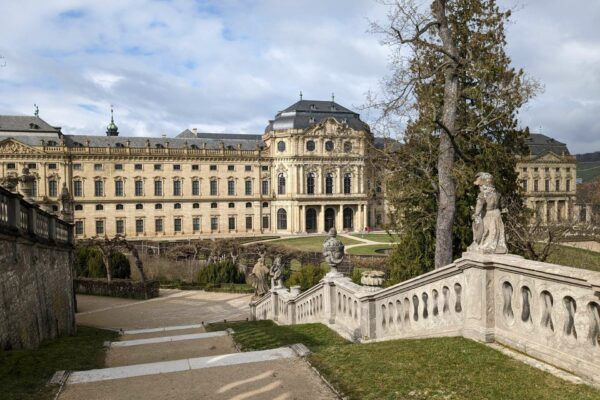
Würzburg Walking Tour
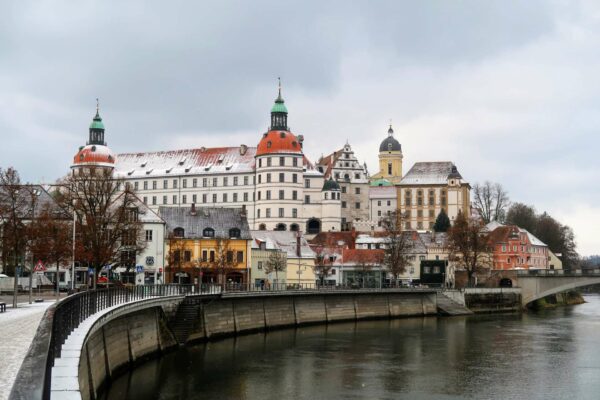
Neuburg an der Donau Walking Tour
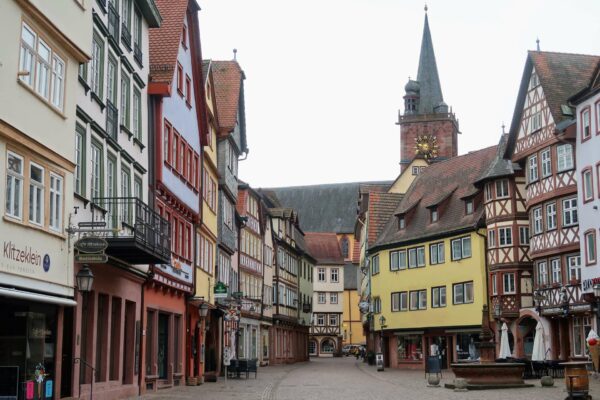
Wertheim Walking Tour
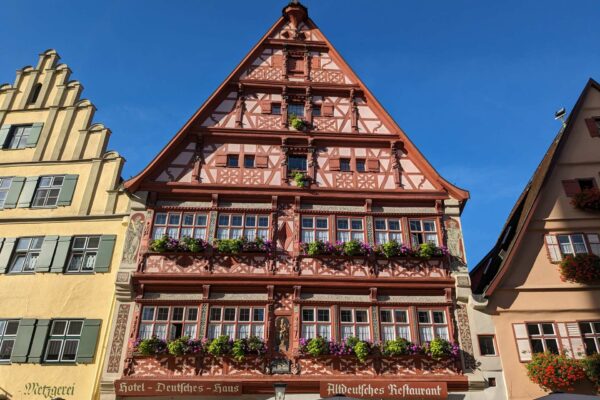
Dinkelsbühl Walking Tour
Thanks so much, this tour is fab. Loved it!!!
I’m glad you liked it! 🙂
Leave a comment Cancel reply
Your email address will not be published. Required fields are marked *
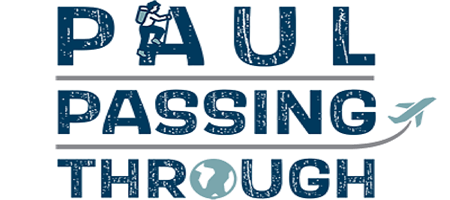
Paul Passing Through is a travel blog designed to give you travel tips, travel recommendations and travel itineraries to help make the most of your travel time!
Free Self-Guided Nuremberg Walking Tour: See All the Highlights of Old Town
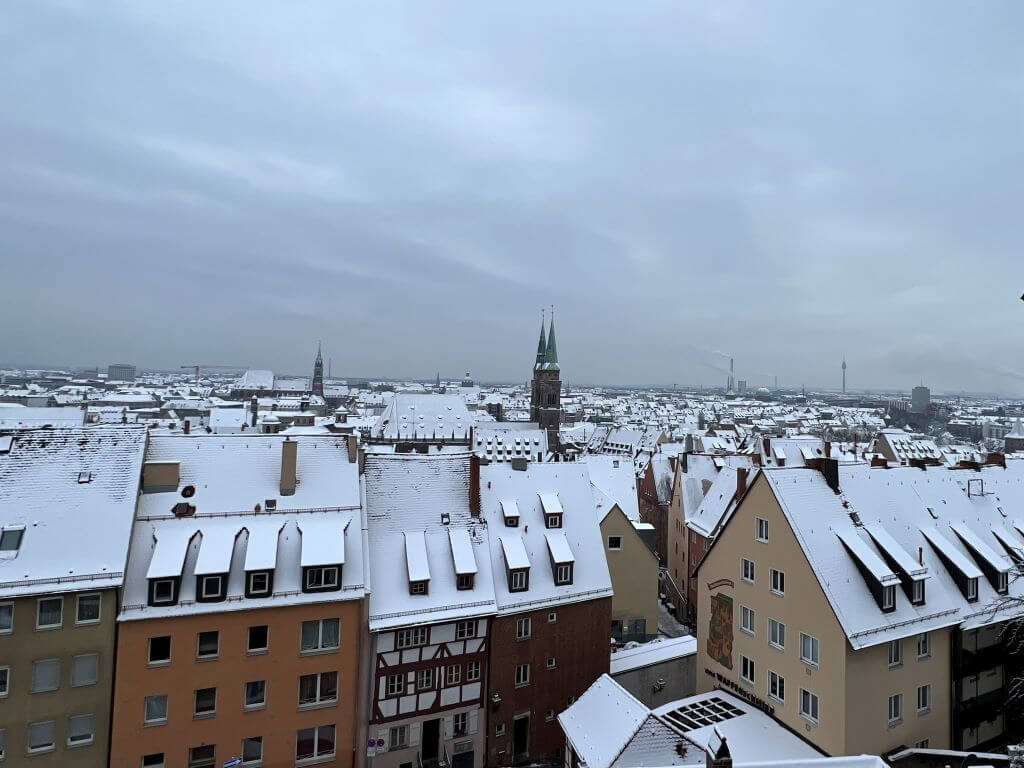
Nuremberg’s Old Town contains a wealth of medieval architecture and history all contained within a very walkable area. This compact design makes Nuremberg’s Old Town an excellent spot to explore on foot. Because of this, I want to share with you my own self-guided Nuremberg walking tour that I put together when I visited in December 2022.
This tour can be done pretty quickly without stopping, but you’ll definitely want to stop to check things out. On this self-guided walking tour of Nuremberg’s Old Town, you’ll see all the highlights while also having the opportunity to stop at several places along the way to delve deeper into Nuremberg’s history.
With that introduction out of the way, let’s see what Nuremberg’s Old Town has to offer!
Disclaimer: This post may contain affiliate links. If you make a purchase through one of these links, I will earn a small commission. This occurs at no added cost to you.
Table of Contents
Quick Glance at My Nuremberg Walking Tour
Below, you can find the order of stops along my Nuremberg walking tour.
Old Chain Bridge
- Tanner’s Row
St Sebald’s Church
Platz am tiergärtnertor, imperial castle, holy ghost hospital, st lawrence’s church, old granary, craftmen’s courtyard.
- Konigstoturm
The total distance from the Old Chain Bridge to Konigstoturm is just around 1.5 miles. If you go directly from end to end without stopping, the walk would take about 45 minutes.
Realistically, you can plan for around 90 minutes to take this self-guided walking tour because you’ll be stopping at least briefly throughout the walk. Add an hour to that time if you include a visit to the inside of the Imperial Castle. If you step inside the three churches, you can add an additional 30 to 45 minutes to your tour.

This walking tour is just a quick overview of many of the city’s highlights. Find more to do with my two-day guide to Nuremberg .
Tips for this Nuremberg Walking Tour
- Start early! I love to do all my walking tours around new cities early in the day. While it isn’t absolutely necessary, it does give you one huge advantage: Starting early lets you beat almost all the crowds. You’ll get to enjoy everything in relative peace and quiet while also not having to maneuver around throngs of people to get from one place to another. Another advantage is that it gives you an idea of places to focus on later in the day. Just take note of any opening hours if you want to stop inside anywhere along the way, and plan to start your walk accordingly.
- I chose the Old Chain Bridge as the starting point of my self-guided walking tour for one specific reason. Starting here allows you to do the entire route in a mostly straightforward fashion without any backtracking except for one very brief stretch. Of course, this partly depends on where your hotel is, but if you stay at my recommended hotel, Hotel Elch, starting at the Old Chain Bridge is the most efficient starting point.
- Dress Appropriately, especially in winter. Nuremberg was around 15 degrees Fahrenheit when we visited and even colder than that when I did this walk. Don’t try to be brave. Wear layers, boots and keep your skin covered where possible. On the other hand, if it’s hot when you visit, dress in thinner, more airy clothes to keep yourself comfortable while walking.
Self-Guided Nuremberg Walking Tour Stops
This self-guided walking tour of Nuremberg’s Old Town begins at the Old Chain Bridge (Kettensteg) spanning the western end of the Pegnitz River just inside the town wall. I chose this as the starting point of the walk for practical reasons, but also because it offers a fine view of the Old Town’s skyline for visitors.
From the Old Chain Bridge, you can look along the river to see various buildings, including the steeples of St Lawrence’s Church. The view is particularly nice if you visit at sunrise. Looking in the other direction, you get a close-up view of that section of the town wall going over the river. It’s not as picturesque as the city view, but it is still neat to see.
The Old Chain Bridge is also notable for being the oldest bridge of its kind in Europe. It was built in 1824 to connect these two sections Nuremberg.
As you stand here admiring the views, it’s worth considering that this section of the river at one time was not so pleasant. This part of town was where many of Nuremberg’s less desirable factories and industries were found.

Tanner’s Lane
After spending a few minutes at the Old Chain Bridge, cross back over to Tanner’s Lane (Weissgerbergasse) for Nuremberg’s most iconic street.
Tanner’s Lane has the largest collection of traditional, half-timbered houses in Nuremberg. These homes are the type that many people think of when thinking about this part of the world, and they’re what give many Bavarian towns a fairy tale-like atmosphere.
The name Tanner’s Lane is associated with the artisans who built the homes and is a testament to the wealth accrued by medieval leather makers. Interestingly, dark-red paint commonly seen on these houses is made from ox blood, which helped to prevent rot.
Now, this enchanting road is mostly lined with cafes and bars. If the old-world charm has you in the mood for a drink served by someone in a rustic frock in a tavern lined with animal pelts, check out Finyas Taverne here on Tanner’s Lane.

Continuing up Tanner’s Lane and turning right on to Weinmarkt brings you to St Sebald’s Church , a large mixed Romanesque and Gothic church. St Sebald’s is notable for being Nuremberg’s oldest city parish church.
If you have a few minutes, pop in to check out the interior. There isn’t much to see that you can’t see in any medieval church, but its dark interior is impressive. If you’re pressed for time, just check out the exterior and keep moving along up the hill via Albrecht-Dürer-Platz to Platz am Tiergärtnertor.

Platz am Tiergärtnertor is one of Nuremberg’s livelier city squares. In addition to the Imperial Castle sitting above the square, it has several other points of interest. The first of these that you’ll come across is the World War II Art Bunker where you can tour the cellars used during the war to protect many of Nuremburg’s historic treasures during the Allies’ air raids.
Continuing into Platz am Tiergärtnertor , you’ll see Der Hase . This somewhat bizarre and creepy sculpture is a satirical monument to one of Nuremberg’s most famous citizens, Albrecht Dürer.
Dürer was one of the most famous artists of the Northern Renaissance. He was born in Nuremberg in 1471 and then died here in 1528. During much of his time in Nuremberg, he lived in a house on the other side of Platz am Tiergärtnertor. This house is now known as Albrecht Dürer’s House and is a museum showing what his life was like here in Nuremberg.
Besides these three tourist attractions, Platz am Tiergärtnertor also has a few cafes and a beer garden to enjoy a drink at while watching the crowds. Because it was cold during our visit, we opted to head indoors for a bite to eat and a beer at Augustiner zur Schranke . It’s small, cozy, has delicious food and excellent Augustiner beer on tap to warm you up on a winter day.
The next stop on my walking tour takes you to the top of the hill to visit Nuremberg’s Imperial Castle (Kaiserburg). Even if you don’t plan to enter the castle, it’s still well worth walking up to its main courtyard.
From here, you get a closer look at some of the architecture of the castle with its red and white half-timbered construction. More importantly, behind the large tower in the courtyard is a fantastic view of Nuremberg that you shouldn’t miss (as seen in the picture at the top of this post).
The Imperial Castle has foundations from around 1,000 A.D. and was first documented as a royal estate of the Holy Roman Empire in 1050. Over time, due to Nuremberg’s strategic location on several important trading routes and because they were using it more frequently, the Holy Roman Emperors added to the castle complex to make it more befitting for royalty. The ruling elite also started to use the castle to host frequent Diets where they would meet to discuss the governance of the empire.
If you decide to enter the Imperial Castle, you can see several rooms, such as some living quarters, a peaceful Romanesque Church and an exhibit with military armaments.
The highlight of the castle is the Upper Hall. This large, open space contains a museum with many interactive exhibits detailing the history of the Holy Roman Empire. It contains more information than you could ever need about this former European power. It’s a great place to better understand the history of Nuremberg and the larger region.

Nuremberg’s Town Hall
After you’re done at the Imperial Castle, exit back towards Platz am Tiergärtnertor. Instead of going back down Albrecht-Dürer-Platz, this time go to the east side of the square. Take Obere Schmeidgasse till it ends at Burgstrasse, and then turn right down this street towards the Hauptmarkt.
Along the way, you’ll pass one museum worth stopping at with time during your trip to Nuremberg and one historical building. The first is the City Museum (Stadtmuseum) to your right. This small museum tells the history of Nuremberg from its heyday as an imperial city to post-World War II.
Shortly after the City Museum, you’ll pass Nuremberg’s Town Hall (Altes Rathaus) on the left. The Town Hall was built in the 14th century to give city administrators a more formal place to conduct business. It was then renovated in the 16th century, with some of the new designs undertaken by Albrecht Dürer. You can visit the medieval dungeons in the basement of the Town Hall with a guided tour, but it doesn’t sound worth your time based on reviews.
Take a look at the Town Hall’s exterior, and then continue along the road till you reach the Hauptmarkt.
Nuremberg’s Hauptmarkt , or Market Square, is the lively center of the city. Prior to the 13th century, Nuremberg actually consisted of two separate towns separated by the river. When the two towns merged, this became the new town center built by Holy Roman Emperor Charles IV.
Today, the Hauptmarkt is most notable for three things: Frauenkirche, its stunning fountain (Schöner Brunnen) and Nuremberg’s Christmas Market.
Frauenkirche is the moderately sized church standing on the eastern side of the Hauptmarkt. This church and all of the square stand on what was formerly the Jewish section of Nuremberg. When it became the central location of the newly united city, the Jews were forced out and 562 were killed. Inside Frauenkirche, you can find a Star of David on the floor behind the altar commemorating this sad chapter in Nuremberg’s history. Outside the church, at noon each day is a short show below the clock depicting the Golden Bull of 1356.
On the other side of the Hauptmarkt is a beautiful medieval fountain worth spending several minutes admiring. Because the river was used to dump industrial waste, this golden fountain was the city’s source of clean water. In addition to its functional usage, it’s also packed with artistic highlights and symbolism. From the bottom of the fountain, each level depicts philosophical and scientific arts, the four Evangelists and four Church Fathers, the seven Prince-electors, the Nine Worthies, and finally Moses and the seven Prophets.
You may also notice a gold ring on the fence surrounding the fountain. According to local legend, spinning this ring three times will bring you good luck.
The Hauptmarkt is also the site of one of Germany’s largest Christmas markets . From December 1st to Christmas Eve, Nuremberg’s Christmas Market (Christkindlesmarkt) fills the square with around 180 different stands selling anything you could possibly need to celebrate the season. It’s a great time to visit Nuremberg to experience its history while also sipping on a glühwein and nibbling away on various Christmas treats.

Continuing through Nuremberg’s Old Town, leave the Hauptmarkt along the road on its southeastern corner. A short walk brings you to one of Nuremberg’s many bridges and one of my favorite spots in town.
Before you get to that spot, take a second to ponder the monument to a 15th-century book The Ship of Fools . The figures in the sculpture depict violence, technology and apathy.
From the bridge, look east to see Holy Ghost Hospital (Heilig-Geist-Spital). This former hospital spans Nuremberg’s Pegnitz River creating a lovely view from the bridge. You can get a little closer by crossing the bridge and going under a short arcade to a viewpoint that juts slightly out over the water.
Holy Ghost Hospital was built in 1339 by one of Nuremberg’s wealthy citizens, Konrad Gross, to care for Nuremberg’s disabled, needy and ill. The section of the building spanning the river wasn’t built till the 16th century, though.
While still on the bridge, if you turn around, you can see the Fleisch Bridge (Fleischbrücke). This single-arch bridge was built in 1598 and believed to have been inspired by the Rialto Bridge in Venice.

Standing Outside St Lawrence’s Church
St Lawrence’s Church (Lorenzkirche) is the next stop on my walking tour of Nuremberg. To get here, just keep walking down Königstrasse. This street, the King’s Street, is one of Nuremberg’s main drags leading from the bridge you just crossed to the Old Town’s southern entrance.
Despite the name Königstrasse, Holy Roman Emperors would typically arrive from the west entrance of town so they could see St Lawrence’s as they made their way through town. It’s fun to stand under the church’s facade while looking out west to imagine the royal entourage parading through town.
The church itself has some great details. It was finished in the 15th century. Initially, it was built as a Catholic church but became Protestant during the Reformation. Fortunately, most of its Catholic decorations survived this era despite the change.
Before you enter, admire the 260-foot-tall facade. St Lawrence’s entrance shows several biblical scenes, including the Passion, Jesus’ birth, the Massacre of the Innocents, Judgement Day and more.

Heading Inside St Lawrence’s Church
After you’re done craning your neck outside, enter the church and take in its vastness. The sheer size of St Lawrence’s Gothic interior is a highlight by itself, but it does have two things that deserve a mention.
The first is the tabernacle that housed Communion wafer. This immaculately carved structure was built in the 1490s by Adam Kraft. You can see his likeness at the bottom of the tabernacle, holding its weight on his shoulders. Like many other artists of the Renaissance, Kraft inserted himself into his masterpiece to declare himself as its creator. At the top of the tabernacle is a wooden figure of Jesus. This is the only part of the structure not made from stone. Kraft used organic material here because Jesus was considered living.
The Annuncation sculpture hanging over the altar is the other piece worth seeing. This wood sculpture was created by one of Nuremberg’s own residents, Veit Stoss, in 1517. It depicts the moment when the Virgin Mary was told by Gabriel that she would give birth to the Son of God. It’s a beautiful sculpture that conveys a remarkable amount of detail whether you’re looking at it from the front or back.
Near the back of St Lawrence’s, you can find photos of the church’s destruction and rebuilding after Allies performed air raids of Nuremberg towards the end of World War II. These photos are a vivid reminder that nearly 90% of Nuremberg’s Old Town was destroyed by these raids. Most of what you’ve seen along my walking tour of Nuremberg is reconstruction after 1945.

A little farther along Königstrasse is a medieval granary (Mauthalle). While not profoundly significant, this large building is an interesting peek into some of the more daily functioning of Nuremberg’s society.
This granary is one of 11 such buildings used throughout Nuremberg to store grain for its citizens. Grain would be stored in the upper floor to be kept safe in the case of famine or siege. The attractively arranged windows on the gable provided adequate airflow to keep the grain free from mold. After 1572, this granary also began to see use a customhouse.
Besides all the history, the granary is just an impressive building with its size and design!

Right next to the entrance to Nuremberg’s Old Town is the Craftmen’s Courtyard (Handwerkerhof). The Craftmen’s Courtyard was built in 1971 to celebrate the 500th birthday of Albrect Dürer. Dürer was considered a master craftsman, so Nuremberg constructed this faux rustic space to house various artisans selling traditional wares.
It may not be from the Middle Ages, but it’s still very cute and worth at least a walk through. This space does hold some history, though. It used to be used as a holding zone for incoming merchants and visitors to be checked out before being allowed entry into Nuremberg.

Konigstortum
The last stop on my self-guided walking tour of Nuremberg is just outside the Craftmen’s Courtyard. Konigstortum is one of Nuremberg’s city towers that guarded one of the city’s four main entrances. This tower was originally square. As cannon’s became more modernized and common, Konigstortum was redesigned in its current form so cannon balls couldn’t make direct impact.
These walls were built between the 12th and 16th centuries. 90% of the town walls, including this section here, are original, albeit restored in many places.

And that’s it! If you’re not too exhausted by this point, you can continue your tour by visiting the Germanic National Museum just a couple hundred yards away from the Craftmen’s Courtyard.
Where to Stay for My Self-Guided Nuremberg Walking Tour
Hotel Elch is an excellent option for visiting Nuremberg, and it’s particularly well suited for my self-guided walking tour. The hotel has pleasant staff who are willing to guide you in the direction of many of Nuremberg’s highlights. They can also provide a map to help with getting around if you need it during your walking tour.
In addition to the friendly staff, the rooms at Hotel Elch are a great place to relax after a long day of sightseeing. Rooms are large, offering you plenty of space if you are visiting with a partner so you don’t feel cramped together. Our room was exceptionally quiet and had a comfy bed allowing us to get good sleep during our stay here.
What makes Hotel Elch ideal for my self-guided walking tour, though, is its location. The starting point of my walk, Old Chain Bridge, is just a short five-minute walk from the hotel’s entrance. This makes it easy to get up in the morning and get going if you want to beat the crowds along the walk.
Resources to Book Your Trip to Nuremberg
Whether you’re looking for tours, hotels or flights, here are some tools to help get you started planning your trip to Nuremberg!
Look for activities and tours offered through GetYourGuide or Viator !
Still can’t find what you’re looking for? Check out my travel essentials pages for more of my recommendations.
Pin This Post!


You May Also Like

A Day in the Fairy Tale Town of Rothenburg ob der Tauber

The Best Things to do in Nuremberg’s Old Town

Visiting Two of the Best Bavarian Castles: Neuschwanstein and Hohenschwangau
Molly | transatlantic notes.
This sounds like a walking tour I would really enjoy; I particularly love the half-timbered houses of Tanner’s Lane as they remind of the ones in Cornwall, UK. If I ever get travelling again, Nuremberg would be a great place to go to!
Javier Garcia Colomo
Thanks for sharing the info. Is there any particular local restaurant, away from tourist traps, that you would recommend me? Cheers,
paulpassingthrough
I did another bigger guide on Nuremberg that goes into food options, but two I would recommend are Augustiner Zur Shranke and Trodelstuben. The latter doesn’t need reservations, but I’d recommend making one because it’s very small inside so limited seating.

Germany > Nuremberg > Free Nuremberg Walking Tour
- Free Walking Tour

Free Nuremberg Walking Tour:
Walking Tour Location : Old Town Nuremberg ( Altstadt ) Cost : Free, Self-Guided ( Museum costs listed below ) Style : Do-It-Yourself Walking Tour ( Self Guided ) Start : Nuremberg Train Station ( Hauptbahnhof ) End : White Tower Subway Stop ( Weißer Turm ) Walking Distance : 2.3 Miles Time : 2 Hours for Walk ( with attractions 6 hours ) Fun Scale : 9.5 out of 10
Old Town Nuremberg Overview:
Being so close to both Munich and Rothenburg, Nuremberg is sometimes the forgetten man in the middle, but it is a true delight to visit. Once one of the mightiest medieval cities in Europe, Nuremberg was 90% ruined by ww2 bombings but has been tastefully rebuilt. The core of any visit will be Old Town Nuremberg which is still squeezed inside an impressive Medieval wall ( largely rebuilt ) and leads up to Nuremberg’s Imperial Castle. This famous castle shaped Old Town Nuremberg as it was the pseudo-capital and seat for the Holy Roman Empire during the Middle Ages.
Divided in half by the Pegnitz River, Old Town Nuremberg is filled with half-timbered homes and has a dense collection of huge churches. The abunance of impressive churches is mainly because Nuremberg was actually seperate towns on each side of the river until it was unified in 1320. This previous division means that there are a lot of hidden gems to find during this free Nuremberg walking tour. There are the big highlights like the churches, castle, and artist Albrecht Dürer’s house, but also underground bunkers and beer cellars. From our numerous visits to this wonderful city, our free self-guided walking tour will take you to all of the can’t miss attractions around Old Town Nuremberg.
1. Nürnberg City Wall & Moat ( Stadtmauer ):
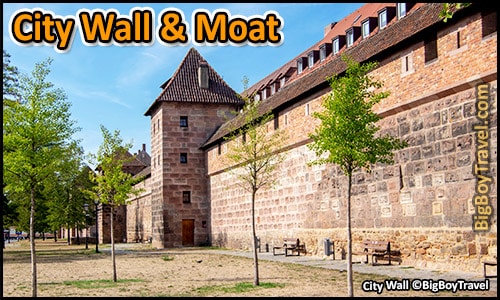
About The Nürnberg City Wall : The village of Nuremberg had some very rapid expansion in the Middle Ages and grew quite powerful thanks in large part to its wonderful network of defensive city walls, towers, and moats. These defenses helped Nuremberg to never be taken by military force for almost 1,000 years until the Americas liberated the city during WW2 in 1945.
The fortifications in Nuremberg were started in the 11th Century as they began to circle independent settlements on each side of the river. The wall took its current 3-mile-long ( 5km ) form long form ( 80% still standing/rebuilt ) when both sides of the river were officially joined into one town in 1320. By 1452 the layout of the wall with a vast 40-feet-deep ( 12 meters ) and up to 65-feet-wide ( 20 meters ) moat was complete with many of the large towers added in the 1500s. While 90% of Nuremberg was damaged by bombings in WW2, the restoration of the city walls, towers, and the moat has been done amazingly well thanks to detailed pre-WW2 photography.
From the main train station, the first thing you see on this free Nuremberg walking tour is the Southeast corner of the Medieval city wall across the street. The traffic in front of the station can be quite busy, but you can take the underground passage inside to avoid the cars which puts you directly exits into the dry moat. We actually prefer to navigate the bustling crosswalks as taking the small drawbridge over the moat as you enter old town Nuremberg feels amazing. The elevated footbridge is also the best place to get some perspective on the scale of the impressive moat before entering the Women’s Gate ( Frauentor ) adorned with the Black Eagle Imperial Coats of Arms. On your return to the station at the end of this Nuremberg walking tour, feel free to take the underground passage.
2. Royal Craftsmen Courtyard ( Handwerkerhof ):
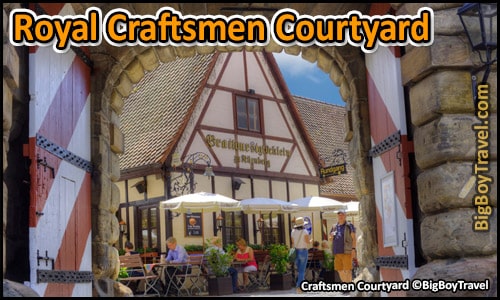
About The Royal Craftsmen Courtyard : As you cross the dry moat and enter Nuremberg’s city wall, you reach the compact Roayl Craftsmen Courtyard. This irregular-shaped square was created inside the former armory’s gun yard ( waffenhof ) in 1971 to celebrate the 500th anniversary of local artist Albrecht Durer’s birthday. The tiny shop houses were only meant to be temporary but because the experience was so popular they kept it. This delightful courtyard feels like a year-round Christmas market where you can see goldsmiths, doll makers, glass cutters, leather workers, gingerbread-makers, and potters hand-creating souvenirs you can buy.
3. Tower of Our Lady ( Frauentorturm ):
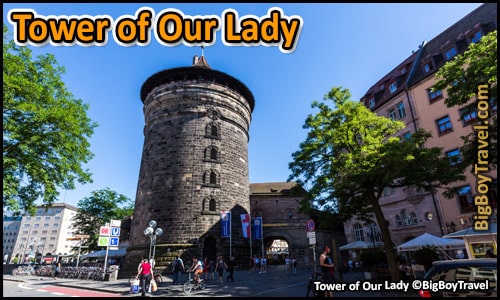
About The Tower of Our Lady : At the end of the Handcrafters Courtyard, is the round Tower of Our Lady which was as one of 160 watchtowers in town during Nuremberg’s peak power. This important tower served as the gateway and toll stop in Medieval times for all visitors from the South ( Regensburg & Munich ) entering Nuremberg. While there are a number of watchtowers and wall sections on our free Nuremberg walking tour, the Tower of Our Lady is our favorite in town outside of towers at the Imperial Castle.
With a 4 color alphabet combo system for referencing the towers along the wall, this was originally called Blue-Q ( Blau-Q ). This coded naming system better helped the city react to attacks and fires as some of the towers had numerous nicknames as the wall expanded.
After the train station opened an automobile bridge into town was opened next to the tower called The King’s Gate ( Königstor ) in 1853, but traffic got so congested that they had to abandon it. Since the subway opened in 1988 the handy underground King’s Gate Passage below the Tower of Our Lady has given better direct access to the station.
4. Saint Klara Convent :
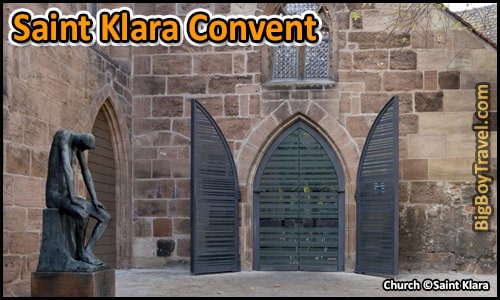
About Saint Klara Convent : The historic Saint Klara Convent ( Poor Claire’s ) operated from 1230 until 1574 when it was closed during the Reformation. The position of the convent helped it thrive as it sat just outside the original city wall boundary next to an important gate known as the Silver Tower. As the city wall expanded outward to its current form in the 1400s, the Catholic convent also grew, but the order of local Dominican nuns was disbanded when the city turned it into a Protestant chapel in 1574.
While most of the original convent was torn down in 1899, the church ( consecrated in 1274 ) and part of the cemetery still survive today. Restorations after WW2 have saved much of the original vaulted rib ceiling above the altar and the church’s Romanesque archway entrance dating to 1270. During the post-war restorations, they found the tomb of influential abbess Caritas Pirckheimer ( died 1530 ) and other artifacts. The church did briefly turn Catholic again when Nuremberg was annexed into Bavaria in 1806 but since the 1990s has been serving a wide range of religious groups and events.
5. Granary & Toll Hall ( Mauthalle ):
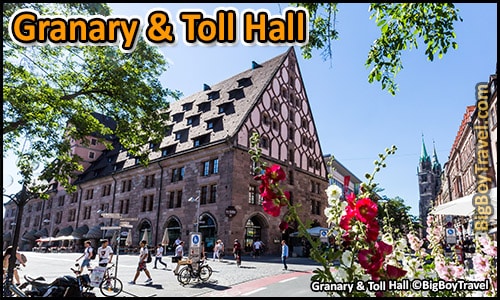
About Toll Hall : The massive Medieval warehouse was built in 1500 to store grain for the citizens of Nuremberg in cases of times of crisis. At 275-feet-long ( 84 meters ), 65-feet-wide ( 20 meters ), and 95-feet-tall ( 29 meters ) this was by far the largest of 12 granaries built by the Free Imperial City of Nuremberg. Prior to the grainy hall, this was the location of the original Inner Women’s Gate ( Inneres Frauentor ) until the city wall had its last expansion outward in 1498.
From 1571 onward, the city’s customs house and municipal scales were located in the ground floor of the granary hall building. Incoming goods from all over the world were checked and universally weighed here. This regulation of incoming commerce gave the hall its official name of name Toll Hall ( Mauthall ).
In Medieval times, the Herrenkeller Beer Hall was located in the vaulted cellars. During WW2, the warehouse was bombed three times from 1943-45 with the first one burning the roof and the last one burning the half the building down requiring a ton of repair. Since 1994 a brewery has returned to the cellars called Barfüßer.
6. Saint Lawrence Church ( Sankt Lorenzkirche ):
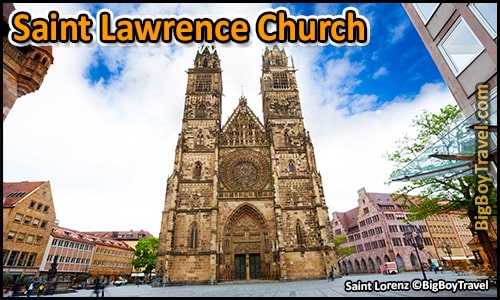
About Saint Lawrence Church : The humungous, twin-towered Saint Lawrence Church ( Sankt Lorenzkirche ) is one of the three most important churches in Nuremberg and is a must visit on this free walking tour. The church began as a three-aisled basilica in 1250 and was the city-parish for the Lorenz neighborhood laying on the South side of the River. From 1439-1477, Saint Lawrence was rebuilt with a Gothic-style nave and choir as the church grew. In 1525 it became one of the first parishes in Germany to turn to Protestant during the Reformation.
The massive scale of Saint Lawrence Church can only be realized as you back up far from the Western facing front facade . From a good distance, you can see the full height of the mighty dual bell towers which stand at 80 & 81 meters tall ( 262 & 265 feet ). The Romanesque-style towers ( like Nuremburg’s Saint Sebald Church ) were modeled after Bamberg Cathedral and the oldest of the 16 surviving church bells were cast in the 1300s. Make sure to inspect the 30-foot-wide ( 9 meters ) indented rose window and carved front portal depicting the Passion of Christ before entering the church.
While much of the bare stone interior of Saint Lawrence Church had to be repaired after WW2, much of the Gothic elements and numerous pieces of religious artwork were preserved. One of the most stunning elements are the Gothic stone ribs supporting the high vaulted ceiling as you enter the nave. The ceiling gets even more impressive as you work toward the main altar and get surrounded by Medieval stained glass windows.
The large hanging pendant near the main altar of the church is called the Angelic Salutation and was gorgeously carved out of limewood in 1518. The painted pendant shows the Archangel Gabriel telling the Virgin Mary that she carry the baby of God ( known as the Annunciation ) which is ringed with scenes from Mary’s life. What is especially unique on the piece is that you can both the front and back side of the figures in great detail which enhances the 3D effect.
Below the Angelic Salutation pendant, the real gem of Saint Lawrence Church is the 66-foot-tall ( 20 meters ) tabernacle . Carved out of sandstone from 1493-1496, the tabernacle not only holds the Holy Sacraments ( wine & bread ) for church services but also shows scenes from the Passion of Christ in elaborate detail. As you follow the multi-story tall scenes, pay attention to the bearded figure at the base which is a self-portrait of the tabernacle’s sculptor Adam Kraft.
7. Lawrence Square ( Lorenzerplatz ):
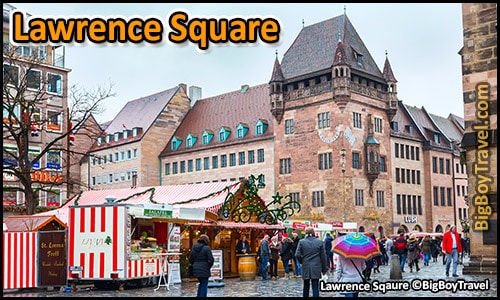
About Saint Lawrence Square : As you leave the Saint Lawrence Church, the large square surrounding it is also worth inspecting further. The most predominant feature of the square after the church itself is the Gothic-style Nassauer Haus which is the last surviving medieval tower house in Nuremberg. In the Middle Ages, urban tower houses littered Medieval villages as they provided both a defensive vertical retreat during invasions while also serving as a status symbol for wealthy families.
The Nassauer Haus built here as early as the 1100s, but the nickname is an erroneous reference to King Adolf von Nassau. We love the corner princess-like bay windows and the timeless sundial on the stately Medieval home. There are also detailed carvings below the roofline showing the of the coats of arms for the Holy Roman Empire, the Pope, variois Electoral Princes, and the city of Nürnberg. The tower house is so beautiful that in 1431, King Sigismund mortgaged his crown to own the property. At the time he was the King of Germany, Hungary, and Bohemia while on his way to becoming the Holy Roman Emperor in 1433.
Also in Saint Lawrence Square is the playful Fountain of Virtue ( Tugendbrunnen ) which was cast from 1584-1589. This unique fountain is capped by a blindfolded Justice holding her scales and sword while supported by the 6 virtues spouting water from their bare breasts . As you circle the emerald green water clockwise you’ll see Faith ( with a cross & cup ), Love ( with two children ), Hope ( with an anchor ), Charity ( with a lion ), Temperance ( with a water jug ), and Patience ( with a lamb ). The Fountain of Virtue is covered during the Winter, but for most of the year you can admire it from every angle. There is also a second tiny fountain along the church called the Devil’s Fountain ( Teufelsbrünnlein ) showing a dragon and the devil taking a schoolboy.
8. Museum Bridge ( Museumsbrücke ):
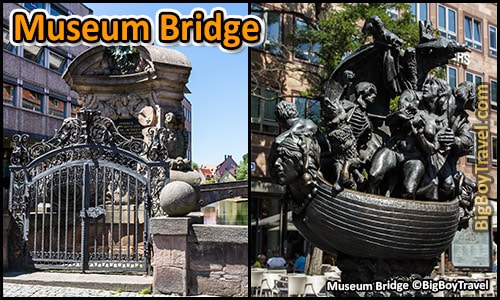
About Museum Bridge : As you follow the natural flow of foot traffic to the North you will reach the Museum Bridge which was the first permanent crossing over the Pegnitz River when it was built in 1200. It was originally called the Barefoot Bridge ( Barfüßerbrücke ) as it connected to the Franciscan monastery with the city and was then renamed the King’s Bridge ( Königsbrücke ) after taking its double arch form in 1700. Side panels show the coat of arms for the places Emperor Leopold I ruled in the day including the Holy Roman Empire, Hungary, and Bohemia, and Nuremberg. The current name of Museum Bridge is a little confusing, but it comes from the high society Museum Club which built reading and social meeting house here ( Königstraße #1 ) in 1810.
After being damaged in WW2 and rebuilt in 1954, the Museum Bridge offers excellent views of the former Holy Ghost Hospital ( Heilig-Geist-Spital ) as you cross the river. Beautifully reflecting on the water, the hospital was built in 1332 through donations by money lender Konrad Gross who was the richest man in town. Gross sponsored a number of large civic projects as soul devices ( Seelgerät ) to help buy his way into heaven and salvation through generous charity. His table style tomb with 8 mourning statues can be seen inside the stunning Crucifixion Court ( Kreuzigungshof ) which also spans the river connects to the Eastside of the Holy Ghost Hospital.
The former hospital is most famous for being the place where the Imperial Jewels and crown of the Holy Roman Emperor were stored from 1424 to 1796 before they were moved to Vienna. Having been damaged in WW2, the rebuilt Holy Ghost Hospital now serves as one of the best restaurants in Nuremberg . The cozy interior is wonderful and it is great that they stayed true to the original design which spans the water and connects to a small island in the middle of the Pegnitz River. Along with the Wine Depot later on this free Nuremberg walking tour, the Holy Ghost Hospital is one of the most beautiful riverfront buildings in town.
While on the Museum Bridge, make sure to look at the Butchers’ Bridge ( Fleischbrücke ) just to the West which was built in 1335. From the side, you can see the delightful curves of the arches which were meant to mimic the Rialto Bridge in Venice, Italy. This elegant version of the Butchers’ Bridge was completed in 1598, survived WW2 undamaged, and is adorned with a huge stone ox from 1599 at the sit of the former meat house.
At the end of the Museum Bridge is the dramatic Ship of Fools Fountain ( Narrenschiffbrunnen ) cast in all black and installed here in 1990. You’ll find figures of Adam & Eve, Cain as a child, and Death crammed into a small ship. The figures are meant to be representations of the woodcuts of Albrecht Dürer made in the 1500s from the moral satire novel The Ship of Fools written by Sebastian Brant in 1497 about violence and threats to the environment.
Restaurant Hours : Open daily at 11:30am with hot meals until 11:00pm.
9. Main Square ( Hauptmarkt ):
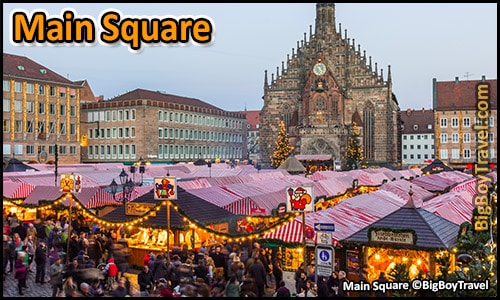
About The Main Square : Nuremberg’s mega-sized Mega Square is has a number of impressive sights and is best known as the home of the largest Christmas market in Europe . In the 1100s this lowland area along the river was settled by Jewish people who had been expelled from Germany’s Rhineland. The neighborhood grew from a swampy marsh to a thriving Jewish community wedged between the two walled sections of Nuremberg located on each side of the river.
After all of Nuremberg was united under one system of walls in 1320 the centrally located Jewish neighborhood started to get chipped away by local authorities. The final blow came when the Ghetto was officially seized under orders from Emperor Charles IV in 1349. Nearly 600 Jewish residents were burned alive in religious persecution ( Plague Pogrom ) on December 5th and the ghetto was demolished in favor of a new vast market square. Just fifty-one years earlier in 1298, over 700 local Jews had been killed here in a similar fashion ( Rindfleisch Pogrom ) in a rampage which saw 20,000 Jewish people across 146 towns. After these two rounds of persecution, the local Jewish community was essentially gone.
The new square over the former Jewish neighborhood was originally called the Green Market ( Grüner Markt ). From Medieval times through 1895, the square was ringed with a horse-shaped colonnade of permanent market stalls ( verschandelung ). Starting in 1495 during the Imperial Days Festival ( Reichstag ) Medieval tournaments once took place in the square.
While there are no more tournaments, today the Main Square still has a weekly market in the Spring through Fall. The biggest event however is the Nuremberg Christmas Market ( Nürnberger Christkindlesmarkt ) which is the largest in Europe fills the entire 5,000 square meter square . The Christmas Market has been going on here since the 1600s.
Today, the Nuremberg Christmas Market has over 2 million visitors a year and 200 wooden stalls with all of the regions of Germany plus many different foreign countries having their own sections. The market spills out onto the neighboring squares including the children’s market with rides, games, and activities in Hans-Sachs-Platz. Among the most famous items to buy at the market are Nuremberg Sausages ( Rostbratwürste ), mulled wine ( Glühwein ) in souvenir mugs, and little men made out of dried plums ( Zwetschgenmännla ).
10. Church Of Our Lady ( Frauenkirche ):
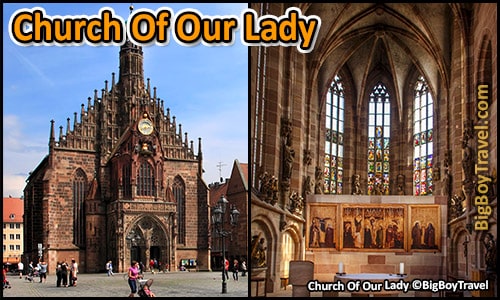
About The Church Of Our Lady : As the focal point of Nuremberg’s Main Square, the beautiful Church Of Our Lady ( Frauenkirche ) was the first Gothic hall church in Franconia . The church was built from 1352 to 1362 on the foundations of a former Jewish synagogue ( built in 1296 ) which was ruined during local religious persecutions. Known as the Pogrom of 1349 , the Jewish community near the synagogue were all either murdered or expelled from Nuremberg after being used as scapegoats for a recent plague.
As the impressive Church Of Our Lady was nearing completion in 1361, the imperial regalia of the Holy Roman Empire were put on public display here for the very first time. This rare public view of the crown and regalia was part of the baptism of Prince Wenzel ( future King of Bohemia ) in the nearby Saint Sebald Church. In some ways the pagentry and show invloved with this batpism was meant to people under the strength of the Imperial Crown.
You can find a depiction of Prince Wenzel’s father, Emperor Charles IV, on the famous Little Running Men ( Männleinlaufen ) art clock on the facade of the Church Of Our Lady. The current version of this glockenspiel clock was completed from 1506-1509 and illustrates the Golden Bull of 1356 . The Golden Bull was a document known as the Nuremberg Code ( 23 chapters written in Nuremberg ) which meant to regulate the appointment of the Holy Roman Emperor set the original 7 Prince-Electors. Emperor Charles IV ( House of Luxembourg ) left his rival houses of Wittelsbach and Habsburg out of the original set of Electors.
Today the Little Running Men art clock goes off with mechanical figures and musical bells every day at Noon . Figures of musicians and Turks play music before two doors open and the seven Prince-Electors ( running men ) circle a throned Emperor Charles IV three times. During World War 2, the figures were kept safe from bombings in Nuremberg’s famous Art Bunker . The globe above the clock shows the current phase of the moon and below it is a balcony where the Christmas Angel has opened the Christmas market every year since 1933.
As you enter the broad nave of the Church Of Our Lady you will see a large Star of David inlayed into the floor of the choir in rememberance of the Pogrom of 1349. You will also see a mix of items inside the church as it switched to Lutheran in 1525 during the Refermation and back to Catholic again in 1806.
The most important artifact at the Church Of Our Lady is the painted Tucher Altarpiece . This stunning work from 1440-1450 was moved here from the now-demolished Augustinian church and is considered the most important pre-Dürer period piece of art in Nuremberg. There are also a few stone sculptures from the 1300s inside the church, but we love the small Medieval stained glass windows the best. Patched with clear modern glass following WW2 damage, fragments of the original Medival window panels inside the Church Of Our Lady are the oldest stained glass in Nuremberg dating back to 1358.
11. The Beautiful Fountain ( Schöner Brunnen ):
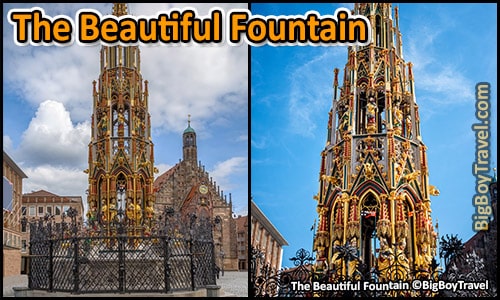
About The Beautiful Fountain : Shaped like a 62-foot-tall ( 19 meters ) Gothic spire, the aptly named Beautiful Fountain ( Schöner Brunnen ) was built from 1385-1396. The four-story-tall fountain has 40 brightly colored figures representing the worldview of the Holy Roman Empire in the Middle Ages of which Nuremberg was one of the most important cities. The main figures on the Beautiful Fountain depict philosophy, the seven liberal arts, the four Evangelists, the four Church Fathers, the seven Prince-electors, the Nine Worthies, Moses, and seven Prophets ( Hosea, Daniel, Jeremiah, Ezekiel, Amos, Isaiah, and Joel ).
While the stunning Medieval fountain has been recast many times over the centuries, the current limestone version from 1902 is impressive as it somehow survived WW2. It was up until this restoration that the Beautiful Fountain’s water was fed by wooden pipes which were then replaced with led one ( no longer led ). The fountain’s paint remains very crisp and we love the cannon shaped spouts which you can dip down to pour out fresh water.
The most notable change to the Beautiful Fountain was the addition of the seamless Golden Ring in 1587 ( replaced many times ) while the lattice fencing was being added. Legend has it that the apprentice of the blacksmith adding the fencing had failed to gain approval to marry his master’s daughter. To prove his skill, one night the apprentice created the brass ring and placed it in the Southwestern side of the fountain’s lattice leaving no visible seam. Today if you turn the golden ring clockwise 3 times it means that you will have good luck, but if you turn it counter-clockwise you will become pregnant. One thing to keep in mind is that Golden Ring only spreads it magic for locals ( Nürnbergers ) and there is a hidden Iron Ring ( added in 1902 ) on the opposite Northeastern side of the lattice to grant the wishes of foreigners ( ausländer ).
One other fountain that is now missing from the square after World War 2 is the massive Neptune Fountain . This fountain was made from 1650-1668 out of melted down guns from the 30 Years War as a symbol of peace. Because of water flow issues, it was never installed and eventually sold to the Tsar of Russia for his palace in Saint Petersburg. After failed attempts to buy it back, the city of Nuremberg was able to cast the original fountain and completed a replica here in the Main Square in 1902 which was the largest Baroque fountain in Germany. Because the fountain was a symbol of peace it was removed by the Nazis who had large militant demonstrations square in the 1930s, but luckily it was preserved and today can be found in the Nuremberg city park.
12. Nuremberg Sausage Restaurants ( Nürnberger Rostbratwürste ):
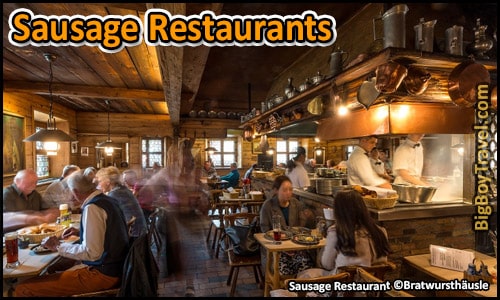
About The Nuremberg Sausage Restaurants : Enjoying an official Nuremberg sausage meal is a right of passage you have to take while visiting. Bratwurst sausages here are delicious and complimented with excellent spicy mustard. To be a true Nuremberg sausage they will be smaller brat links made at a specific length and weight. The number of sausages also has its own traditions with plated meals served in even numbers of 6 to 12, but inside a bun there are always 3 sausages. Washing it down with a local beer, a side of soup, and an apple strudel makes your meal even more pleasant.
The two most famous establishments each sit one block North of either end of Nuremberg’s Main Square. Off the Northwest corner next to Saint Sebald Church is the timeless Bratwursthäusle bei St. Sebald which has been cooking in an open-style kitchen since 1313. Located inside a small Medieval house, the setting to eat here is a true experience. Lines here can get long in the afternoon and it is important to note that they are closed on Mondays. The same family also has a brat stand inside the Royal Handcrafters’ Courtyard and different restaurant on Sebalder Square called the Golden Posthorn.
Off of the Northeast corner of the Main Square behind the Old Town Hall is the other famous place called Bratwurst Röslein. This building is much larger and modern than Bratwursthäusle, but they do have a number of themed side rooms that resemble rural Alpine hut restaurants. We have never had an issue getting a table here even during peak Christmas Market season. Although the name implies Bratwurst Röslein is a sausage place, they also have other great hearty German dishes to please your stomach. If you are looking to sit outside, Bratwurst Röslein also has a large 250 person beer garden that spills across the tiny Town Hall Square in front of the restaurant.
One of the most atmospheric sausage places in town is Zum Gulden Stern which sits not far from Saint Jacob’s Church at the end of this free Nuremberg walking tour. Opened in 1419, it is the oldest brat place to still be in its original location and is often less full of tourists. If you are in a hurry there are also numerous street vendor stands throughout Nuremberg to grab a sausage on the go at budget-friendly prices.
13. Old Town Hall ( Atles Rathaus ):
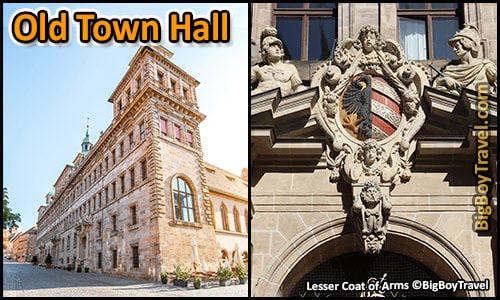
About The Old Town Hall : Earlier in this Nuremberg walking tour we learned how the Jewish Ghetto was seized by the city ( including a mass killing in 1349 ) to form the main Market Square. Prior to this, the local administration had already begun to reorganize the center of town as the Nuremberg city council started meeting here inside the warehouse of a wealthy cloth merchant guild ( Gewandhaus ) on nearby Cloth Alley ( Tuchgasse ). They later acquired the bakery shops owned by the Heilsbronn Monastery and built a Gothic-style Town Hall at the present location from 1332-1340. The earth around the buildings was raised up and the former street level of the bakery became the underground cellars of the Town Hall. These cellars served as Nuremberg’s Medieval dungeons ( Lochgefängnisse ) from 1340-1806 and are pretty interesting to tour, but first we want to give you an overview of the Town Hall Complex itself.
On the Southside of the current complex, you can still see the Old Town Hall ( Altes Rathaus ) built over the former bakery with an Eastern facade. The upper floor of this Gothic section with an arched wooden ceiling is known as the Great Hall ( Groß Rathaussaal ) and was a masterpiece in Medieval times. Thanks to the designs of local artist Albrecht Dürer, renovations in the Great Hall from 1521-1530 gave it the largest wall and ceiling mural in Europe at the time. Depicting the triumphal procession of Emperor Maximilian I and scenes from the Last Judgement the room held its largest mural in Europe statue for 10 years until the Sistine Chapel interior was finished in 1541. The exterior of the Old Town Hall also had full-height murals on it from the 1500s-1900s. The Great Hall stayed important as it held the Banquet of Peace in 1649 when the opposing sides from the 30 Years Wars met to make peace.
As you work around the Westside of the Town Hall complex you will notice that the architecture drastically changes to resembles a palazzo as it was designed in the Italian Renaissance-style. This 4-wing addition with an inner courtyard was built from 1616-1622 although it wasn’t fully finished until after the 30 Years War. Preserved on the Western facade are carved Baroque reliefs above each of the three Doric-style doorways depicting figures from The Book of Daniel.
Above the first portal which leads to the Spiessgeselle Restaurant ( website ) is Nuremberg’s Lesser Coat of Arms. Around the coat of arms is the many-headed leopard ( left ) representing Greece with Alexander the Great and the animal with ten horns ( right ) representing Rome with Emperor Julius Caesar. The middle horn also has a tiny face of the Pope. The middle portal which leads to the Medieval Dungeon tours is the full double-headed Imperial Eagle Coat of Arms ( Reichsadler ) of the Holy Roman Empire. Roman Goddess of Justice ( left ) holding a sword and scale plus the Goddess of Truth ( right ) called Veritas holding a mirror as the courthouse was also inside the Town Hall. The third portal has the Greater Coat of Arms of showing the golden King Headed Eagle ( Königskopfadler ) which has been used as Nuremberg’s seal since 1240. Lion ( left ) representing Babylon with King Nebuchadnezzar and a bear ( right ) representing Persia and King Cyrus.
Much of the interior of the Nuremberg Town Hall was ruined in a fire from bombings in WW2. While most of the complex has been restored, the famous murals inside the Great Hall have been lost.
14. Medieval Dungeons ( Lochgefängnisse ):
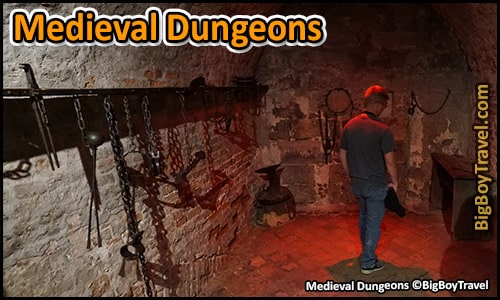
About The Medieval Dungeons : Below the Old Town Hall are the cellars which served as Nuremberg’s Medieval dungeons from 1340-1806. Having survived the fire during WW2 bombings, the dungeons were restored and opened for daily public tours in 2018 and we were among the first people to visit them. The tours of the dungeon are very interesting and give you an excellent insight into the depressing justice system in Medieval times. With the municipal court located above the dungeons, they could torture you into a confession, get you sentenced in front of the judge, and get you off for punishment or execution pretty quickly without recourse in those days.
You start your visit to the Town Hall Dungeons in a restored Gothic hall where receive you an audio guide to start the hourly group tour. As you descend into below-ground you see a Medieval well, the old blacksmith forge, and multiple rooms with torture devices of the time. It is interesting to see the devices up close and the most powerful is the large rack displayed in the former chapel room which would pull prisoners by their limbs.
Our favorite area of the Medieval Dungeons tour are the 12 prisoner cells along a long stone corridor. It is in this corridor where you can make out the original street level road and half-timber shop entrances that the Old Town Hall was built on top of from 1332-1340 to form the cellars. The dozen holding cells, called hole prisons ( Lochgefängnisse ), are quite small at roughly 6.5 feet by 6.5 feet ( 2m x 2m ) with vaulted ceilings. Some of the prisoners were held here prior to public execution while many others were brought to the dungeons for torture to extract confessions. The coolest rooms are Cell 11 which is marked with a Red Rooster to hold arsonists and Cell 12 which is marked with a Black Cat to hold slanderers.
You can get an idea of how gruesome the punishments were in Medieval times before your visit by reading the book A Hangman’s Diary . The eerie book is translated from the detailed journal of Franz Schmidt who served as the Nuremberg executioner from 1573-1617. His detailed writings show he executed at least 361 people and 345 were beaten with rods to go along with countless others who had their ears and fingers cut off as punishment. Later on this free Nuremberg walking tour, we will visit the Hangman’s Bridge ( Henkerssteg ) which led to the tower the executioners lived in.
Tour Hours : Tours start daily on the hour 11am-3pm and last 30 minutes. Cost : 4€ for Adults and 1.50€ for kids. Important Information : Hourly tours are limited to 20 people and led by a guide but done through the provided audio guides available in German, English, Spanish and Italian. Due to the underground tunnels, they do not advise the tour for guests under the age of ten years old and it is not wheelchair/stroller accessible. Website : Here . Time Required : The tours take 30 minutes but expect a 60 total visit as you need to arrive early.
15. Fembo House City Museum :
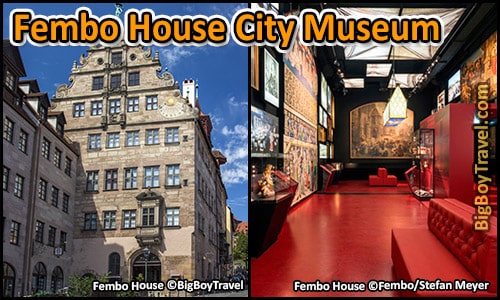
About The Fembo House : The well preserved Fembo House is Nuremberg’s only surviving large merchant’s house from the late-Renaissance. Sitting halfway up the hill to the Imperial Castle the facade of the mansion built by wealthy silk merchant is still very impressive. The home was later owned by two other patrician families ( Wilhiem and Fembo ) and now serves as the City Museum.
A tour of the 30 rooms over 4 floors gives you a great overview of city history of Nuremberg from middle ages to 1800s. We especially love The Beautiful Room which was built as part of the Peller Mansion on Egidienberg Square in 1610 which was considered the finest in town. Prior to being bombed inWW2, the woodwork, ceilings, paneling, and paintings from this room in the Peller Mansion were moved to protective storage and later re-assembled here at the Fembo House. Other rooms include a family hall, a private ballroom, and the kitchen of the Fembo House which have most of the elements dating back to the 1600s.
Since 2016 the Fembo house has also been home to the official replicas of the Imperial Crown and Jewels ( Kronschatz ) . The originals were held in Nuremberg’s Holy Spirit Hospital from 1424 for nearly 400 years and are now on display in Vienna since 1800.
Hours : Tuesday-Friday 10am-5pm; Saturday & Sunday until 6pm; closed Mondays. Address : Burgstraße 15. Website : Here . Time Required : Expect around 60-90 minutes on average to tour the inside of the Fembo House with a quick 30-minute visit being doable. We prefer to see it from the outside if you are only in Nuremberg for one day, but tour it if you are here for at least two days.
16. Imperial Castle of Nuremberg ( Kaiserburg Nürnberg ):
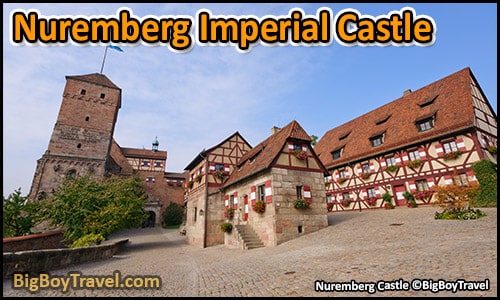
About The Imperial Castle : They have found evidence of a settlement on Castle Hill that dates back to before the year 1000, although the current castle was started in 1050. Bewteen the Salier family, then Staufer, and Hollenzoller burggave, it served as the defacto main seat of power for the Holy Roman Empire until 1571.
Hours : Daily. Website : Here .
17. Castle Garden & Wall Walk ( Burggarten ):
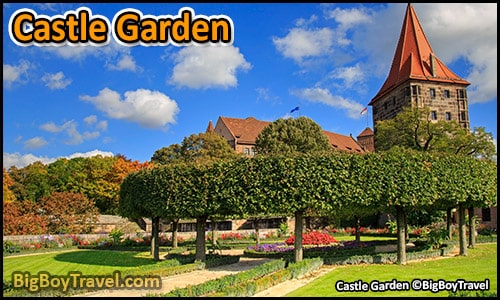
About The Castle Garden : Slightly hidden just outside of the City Walls to the West of the Imperial Castle is the wonder Castle Garden. Many tourist totally miss out on the delightful garden as the entrance is located along the wall halfway up the hill between the Animal Garden Gate Square ( Platz Am Tiergärtnertor ) and the Imperial Castle.
The general layout of the Castles Gardens was started in the 1000s by Emperor Frederick I ( 1155-90 ) and the oldest depiction of the Imperial Castle ( 1425 ) shows a tree garden with a braided fence. Emperor Friedrich III ( 1440-1493 ) expanded area with a hanging garden to storing wine under. Later, between 1538 and 1545, the fortified bastions were built on the North and West sides of the Castle on which the current version of the castle garden was created.
Today there are three main areas to the Castle Garden. The first is when you walk straight out and go to the right ( North ) which has trees and a shed that leads to an underground tunnel for taking tours of the Medieval water system. The second area ( Südlicher Burggarten ) is slightly to the South which has a huge circle of manicured trees forming a ring and surrounded by flowers. This area of Lace Trees ( sophora ) provides stunning views of town, especially during sunset.
The third section is called the Mayor’s Garden ( Bürgermeistergarten ) and continues further South on a narrow strip clinging to the outside of the wall on and filled with sculptures. It is at the start of the 3rd section where you will find both the public bathrooms and the entrance to walk on top of the Medieval wall . From this covered section of wall directly across from Albrecht Dürer’s House, you can look down into Animal Garden Gate Square.
Hours : Open daily from April through October from 8am-Dark ( 8pm at the latest ) . Cost : Free.
18. Animal Garden Gate Square ( Platz Am Tiergärtnertor ):
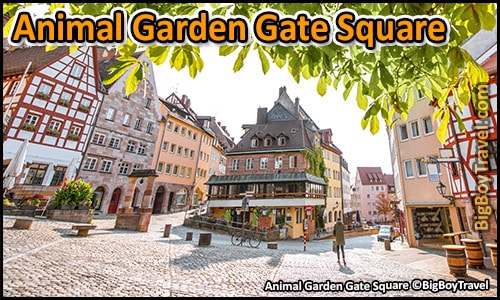
About Tiergärtnertor : The main square of the upper part of town with many stunning buildings which serves as Nuremberg’s outdoor living room. The main gateway used to be at the bottom of the tall watchtower which was later bricked up in favor of the long winding tunnel next to it that cut through the outer wall under the bastion. Because this gateway led to a royal game preserve inside the moat during the time of the Burgrave, it gained the name Animal Gardener Tower ( Tiergärtnertor ).
was the main entrance into the city of the city wall and its 128 towers. Tiergärtnertor bastion, where you can walk on a short stretch of the battlements. From there you have a fantastic view of the Tiergärtnertorplatz and the Albrecht Dürer House.
Pilatushaus from 1489 and belonged to the Plumber (Plattner) Hans Grünwald who built armor and lances for noblemen. St. George as the dragon slayer , the saint of knights and plumbers. called the Pilatushaus since the 1700s as it was the start of the Stations of the Cross 7 floors (sandstone basement, 3 above ground, and 3 in roofline)
– a typical example of a home of a prosperous artisan from the 15th century – you’ll find an oversized bronze sculpture: The “Dürer Hare”. The artwork, which was created by the artist Jürgen Goertz in 1984, references Albrecht Dürer’s famous watercolor “Young Hare”.
19. Albrecht Dürer’s House & Museum :
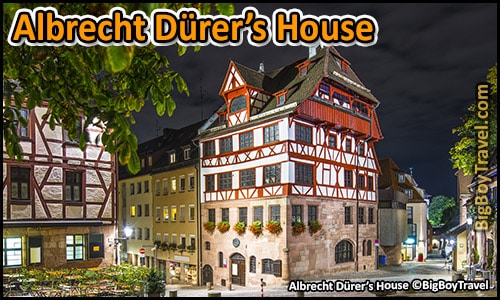
About Albrecht Dürer’s House : The most stately Medieval mansion on Animal Garden Gate Sqaure ( Platz Am Tiergärtnertor ) is the former home and workshop of the famous local artist Albrecht Dürer. He worked at the same era as Michelangelo and was considered Germany’s greatest painter. Dürer was a groundbreaking Renaissance artist who signed all his paintings for branding and mastered engraving prints for re-production which made him super rich.
With his wealth, Albrecht Dürer was able to buy this mansion near Nuremberg Castle in 1509 where he lived until his death in 1528. The lower part of his home was built in 1420, but the upper part is where he did most of his best works from ‘The Hare’ ( on display in Vienna ) to his self-portraits ( on display here ).
Touring Albrecht Dürer’s home today is a highlight of this free Nuremberg walking tour. You’ll multiple levels of the artists’ works, the rooms in which he lived, plus replica copperplate engraving and woodcutting demonstrations upstairs. Multiple times a day they do live demonstrations where you can make your own engraving to take home as a souvenir.
Hours : Tuesday-Sunday 10am-5pm; Thursdays until 8pm; closed Mondays. Cost : 6.50 for Adults; 1.50€ for students. Website : Here .
20. Medieval Beer Cellars Tour ( Historische Felsengänge ):
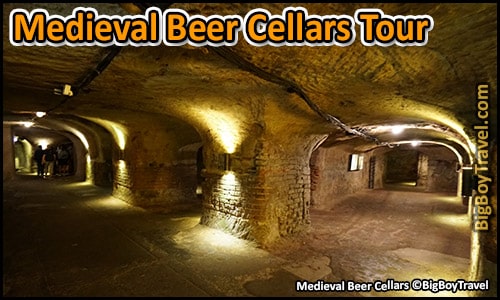
About The Medieval Beer Cellar Tours : Nuremberg’s “Purity Law” goes back to 1303 when the Town Council ruled that only barley malt ( and no other grain ) could be used to brew beer. On November 11th, 1380, the city council decreed that anyone intending to brew and sell beer must have a cellar of his own, “ten feet long and sixteen feet wide.” This led to the citizens of Nuremberg digging vaults and passages in the bright red sandstone under their city. After modern refrigeration, the rock-cut cellars lost their importance, but they did serve as bomb shelters for thousands of citizen as WW2 air raids destroyed 90% of old town Nuremberg.
During an exciting one-hour-long tour of the rock-cut beer cellars today, you will descend below the streets of Nuremberg to learn the extensive history of the tunnels. The Medieval history is very interesting covering the tunnels uses as a storage place for both beer and pickles. They even came up with an ingenious way to bring in snow and ice in the Winter to help the cellars stay cooler much longer into the Spring which was good for brewing beer. At the end of the guided tour, you even get to sample local red beer or whiskey from the Altstadthof Brewery. The brewery, which opened in 1984, sits at the historic location of the former Red Brauhaus. We really love the red beer at Altstadthof Brewery which is something Nuremberg is famous for, but the whiskey is also quite good. Overall, visiting the Medieval rock-cut beer cellars is one of our top three things to do on this free Nuremberg walking tour.
Tour Hours : 60-75 minute long tours are normally in German but with audio guides available in many languages. Daily every hour from 11am-5pm. Special Tours In English : Saturdays & Sunday at 11:15am and you get more info than the audio guide version during the German tours. Cost : 8€ for adults; 7€ for students; ages 7 and under free; includes one free taste testing of whiskey or red beer for every paid admission and the option to add on more. Website & Tickets : Here .
21. Historic Art Bunker ( Historischer Kunstbunker ):
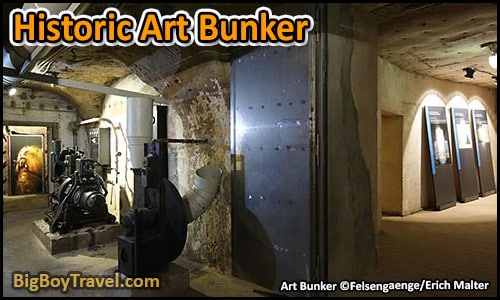
About The Historic Art Bunker : During WW2, one of the section of Medieval rock-cut cellars was turned into a climate controlled bunker to preserve much of Nuremberg precious works of art. While the artwork was also held in some salt mines in hast, the planned bunker in Nuremberg was the only one of its kind for most of the war.
It’s astonishing that for as bloody thirsty for destruction the 3rd Riech was during the war that they took such big measures to preserve art. In Nuremberg, this effort started with climatized cells were already being built in a section of the rock-cut cellars below the Imperial Castle a full year before the planned war broke out . The entrance to the Historic Art Bunker was hidden inside the home at Obere Schmiedgasse #52 where you still enter for tours today. Humidity was controlled, ventilation was installed, insulation was added to regulate the temperature, and backup power cells were built.
While most of Nuremberg was leveled in WW2, the Historic Art Bunker helped to preserve countless works . Much of the local treasures stored here were from the 1500s when Nuremberg was at its cultural peak. Local items held here included the Annunciation Medallion ( Englischer Gruß ) from Saint Lawrence Church, the mechanical clock figures ( Männleinlaufen ) from the Church of Our Lady, many works by Albrecht Dürer, Martin Behaim’s Globe, numerous religious altars, the Holy Roman Emperor’s Imperial Crown & regalia, and countless stained glass windows. Also stored were precious artifacts from all over Germany including codex from Heidelberg and the Virgin Mark Altar from Krakow. Many of these pieces were kept in the Art Bunker after the war and not moved back to their original homes until the re-construction of Nuremberg was complete in the 1970s.
Tour Hours : 75-minute long tours are normally in German but with audio guides available in many languages. Monday-Thursday 2:30pm; Friday 2:30pm & 5:30pm: Saturday 11:30am, 2:30pm, and 5:30pm; Sunday 11:30am & 2:30pm. Special Tours In English : Saturdays at 3:30pm and you get more info than the audio guide version during the German tours. Cost : 7€ for adults; 6€ for students; Ages 7 and under free. Website & Tickets : Here .
22. Saint Sebald Church ( Sebalduskirche ):
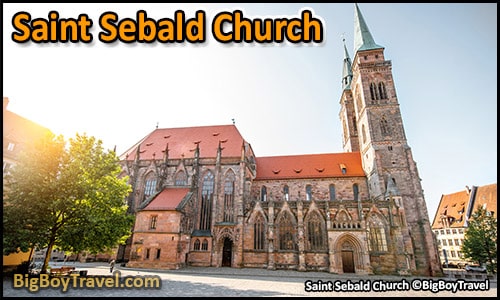
About Saint Sebald Church : Built in the Romanesque-style in 1225, Saint Sebald is the most important of the three main churchs in Nuremberg. The church was long the city parish for City Council and is named after Nuremberg’s Patron Saint Sebaldus who if buried inside. Saint Sebaldus ( canonized in 1425 ) was a hermit who has had a following in Nuremberg since as early as 1072.
As Nuremberg’s main City Parish, Saint Sebald Church gained fame in 1361 when the Emperor Charles IV had his son Prince Wenzel ( future King of Bohemia ) baptised here in 1361 . For the grand celebration new stained Medieval glass windows were added which are some of the oldest and best preserved in Germany. This status also helped the church aquire the bones of Saint Sebaldus in 1397 which created a stream of pilgrims for the parish.
Further changes came to Saint Sebald Church in 1483 when it was expanded and gained a 5th and 6th floor. The exspansion led to a drastic change to the interior including giant stone pillars to hold up the new Gothic ribbed cieling . There was also a lot more room to display priceless works from art from painted Tucher Epitaph and the new bronze tomb for Saint Sebald which was cast by bronze by Peter Vischer and his sons from 1508-1519. Sitting in the middle of the main isle, the huge tomb is considered a masterpiece of the German Renaissance.
On the Northside of the church is Sebalder Square with a couple of cool houses and the Goldenes Posthorn which is the oldest wine tavern in town. Opened in 1498 it was the local pub of Albrecht Dürer and Hans Sachs.
Visiting Hours : January-March daily 9:30am-4pm; April-December daily 9:30am-6pm. Cost : Free to enter although a modest donation is common the entrance. Guided Tours : On many evenings in July and August they have tours available for 4 euros which also lets you hear the live organ music. Tower Tours : You can request a tour of the towers by email two weeks in advance for 40 euros covering 7 people and 5 euros extra for each additional person ( 24 max ). Website : Here .
23. White Tanners’ Lane ( Weißgerbergasse ):
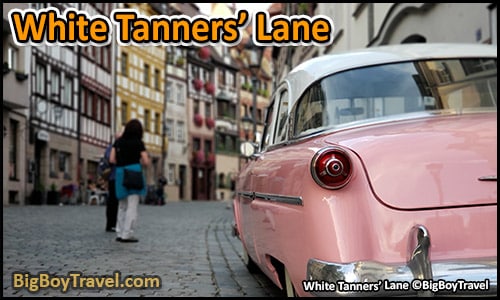
About White Tanners’ Lane : The long continuous collection of colorful half-timber homes in Nuremberg is along the curved White Tanners’ Lane ( Weißgerbergasse ). In total, 20 historic townhomes survived WW2 and give us an idea of the original appearance of the affluent streets of the Old Town Nuremberg.
The name White Tanners’ Lane comes from the craftsmen who lived on the street that used white alum powder ( potassium aluminum sulfate ) to create fine leather. While it is a romantic stroll, in Medieval times the tanning process stunk horribly and required flowing water to toss animal scrapes. Because of this, the tanners had to set up on edge of town where the Pegntiz flowed outward, but lucky for them that most of them were wealthy enough to have their own in-house well for clean water.
After the animal hides were soaked and tanned, they were beaten for softness, scraped clean with a curved rammer blade and hung on the city wall to dry. You can still see trade and symbols at some of the homes including a rammer knife at Weißgerbergasse #24. Today, the White Tanners’ Lane is a favorite spot not just for photographers, but also for bars, cafes, and handicraft workshops.
24. Wine Depot ( Weinstadel ):
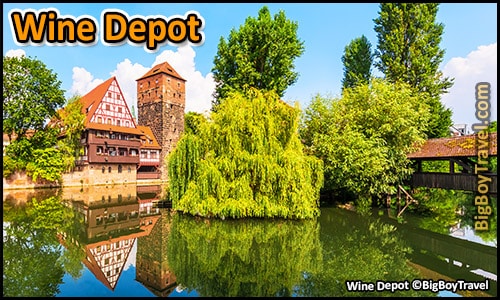
About The Wine Depot : Stepping out over the Pegnitz River on the Maximilian Bridge ( Maxbrücke ) leads you to the most iconic viewpoint in Nuremberg; the Wine Depot & Hangman’s Bridge. With slow-moving water reflecting a dramatic weeping willow and neighboring Medieval buildings, the scene looks like a real-life painting. Once you see it you will realize why this viewpoint is one of the 5 must sees on our free Nuremberg walking tour.
The first striking structure is the largest half-timbered building in Germany ( 48-meters-long ), known as the Wine Depot ( Weinstadel ). While it is one of the most beautiful buildings in Nuremberg it was built in 1446 as a leprosy hospital ( lepraspital ). Only once a year, the lepers who were allowed into the city walls for just three days over Easter to receive food, clothing, and medical attention. Starting in 1571, the Wine Depot was turned into a wine storage hall, a work and spinning house, and as housing for poor families. Gutted by damage in WW2, since 1950 it is student housing for the university.
25. Hangman’s Bridge ( Henkersteg ):
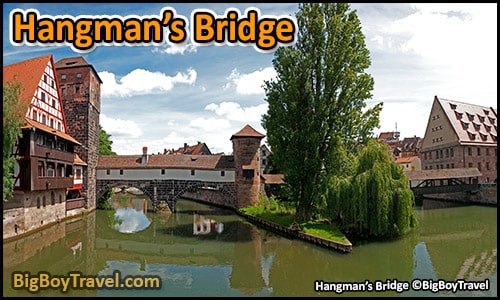
About The Handman’s Bridge : Next door to the Wine Depot is the stone tower where Nuremberg’s hangman lived in Medieval times. When it was built in 1320, this tower house was on the outer edge of the original city walls and faced away from town toward the West. This placement was because, during the superstitious Middle Ages, the executioner was not allowed to have contact with “honorable citizens”. In 1457, the wooden Hangman’s Bridge ( Henkerssteg ) was completed as a path for the executioner to cross the river from his house separate from the normal population . The timeless bridge was rebuilt with covered roof following the Flood of 1595 and crossing it today is one of the most tantalizing stretches of this free Nuremberg walking tour.
At the end of the covered Hangman’s Bridge, the former executioner’s tower house which opened in 2007 as a gallery covering the criminal history of Nuremberg. You can get an idea of how gruesome the punishments were in Medieval times before you visit Nuremberg by reading the book A Hangman’s Diary . The eerie book is translated from the detailed journal of Franz Schmidt who served as the Nuremberg executioner from 1573-1617. His detailed writings show he executed at least 361 people and 345 were beaten with rods to go along with countless others who had their ears and fingers cut off as punishment.
Exiting the Hangman’s Bridge at the halfway point puts you onto Flea Market Island ( Trödelmarkt ) was a pig market and a market of “junk shops” in the Middle Ages. Today the junk shops have been replaced by boutique stores and one of our favorite beer halls in town known as the Junk Tavern ( Trödelstuben, website ). From the island, you can return back to the heart of town but we prefer to continue the walking tour South across the obelisk filled Karl’s Bridge ( Karlsbücke ) and the Emperor’s Lane ( Kaiserstrasse ) filled with the most exclusive shopping in town.
Hangman Gallery Hours : Saturdays & Sundays April-December 2-6pm. Cost : 2€. Website : Here .
26. Ludwig’s Square ( Ludwigsplatz ):
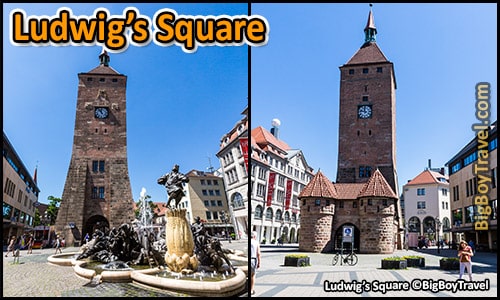
About Ludwig’s Square : As you enter the lengthy Ludwig’s Square you immediately run into our favorite coffee shop in Nuremberg called Brown’s Coffee Lounge ( website ) which has outdoor seating wrapping around a sprawling fountain. The rest of the square is a little boring until you reach the mighty White Tower ( Weißer Turm ). Built in 1250, this Medieval watchtower is one of the only remaining elements from Nuremberg’s second to last city wall expansion. Because of its age, the white paint that originally gave the tower its name has faded to expose the bare bricks. We find it really cool that you actually enter the base of the White Tower to reach the underground subwa y which can take you back to either Saint Lawrence Church or the Main Train Station.
Directly in front of the timeless White Tower is our favorite piece of outdoor art in Nuremberg called the Marriage Merry-Go-Round Fountain ( Ehekarussell ). Cast out of bronze in 1984 by artist Jürgen Weber, the sprawling fountain is meant to playfully contrast the positive and negative aspects of married life. Much like the Ship of Fools from earlier on this free Nuremberg walking tour, the Marriage Merry-Go-Round is also based on a historic written work. The poem from 1541 by Hans Sachs called “The Bittersweet Married Life” covers the stages of marriage from erotic passion all the way through death and is brought to life with the modern fountain. As you circle the dramatic work, make sure to take in each marriage scene as well as a depiction of the poet standing high on a pedestal.
Before entering the subway, you will really want to see the White Tower from the outside where you can see the stubby flanks of the original gateway into the former section of the city wall. Continuing further to the Southern edge of the square brings you to the historic Saint Jacob’s Church ( Saint James the Greater ) largely surviving from the year 1360 ( founded in 1209 ) and the green copper dome of the Saint Elisabeth Church from 1785-1803 ( established 1235 ). Neither church is overly exciting to visit today but Saint Jacob’s was very important for Medieval pilgrims as one of the main routes for the Saint James way from Prague to France, and eventually, Spain ran through Nuremberg.
Featured Article

Sign Up For Our Newsletter For Free Travel Tips
Email Address *
Disclaimer: Information on this page and in our walking tours were deemed accurate when published, however, details such as opening hours, rates, transportation, visa requirements, and safety can change without notice. Please check with any destinations directly before traveling.
Free walking tours in Nuremberg
The best guruwalks in nuremberg, nuremberg essential free tour, free tour of nuremberg's old town, nuremberg free tour oldtown +3rd reich history, a walk through the historic center, lots of history and stories, in small groups, free tour nuremberg old town, historical tour and legends of the old town of nuremberg, free tour through the old town of nuremberg in small groups.
Best things to do and see in Nuremberg
Nuremberg is a German city that is located in the Franconian region, which is part of the state of Bavaria being the second largest city of the same after Munich. The river Pegnitz is part of the walled city and although it has been a city that has hosted the most important assemblies of the Holy Roman Empire, after the Second World War, the city was devastated and had to be rebuilt. It was the seat of one of the most important trials in history although it is also the birthplace of the Renaissance artist Albrecht Dürer. Currently, we can also find in this city the best Christmas market in Germany. If you are looking for the best things to do and see in Nuremberg during your visit, do a free tour with a local guide can be an option to know the essential places as well as history and culture through the most important streets of the city. Some points of interest that you should visit are the imperial castle of Nuremberg (Kaiserburg), the executioner's bridge, the house of Albrecht Dürer, the German National Museum, the Zeppelin Field as one of the most important stages of the III Reich, the Catholic Church of Our Lady (Frauenkirche), the church of St. Lawrence (Lorenzkirche), the church of St. Sebald (Sebalduskirche), the central square Hauptmarkt where the Christmas markets are held, the Documentation Center in the Old Congress Grounds of the National Socialist Party , the bunkers and anti-aircraft shelters or the court where the Nuremberg trials were held. All free walking tours in Nuremberg have opinions and ratings from travelers who have made the different routes through the city. That way, you can know a little better what kind of experience each tour brings. Other cities that also have guided tours are Berlin, Cologne or Dresden or Prague.
Others cities to visit after Nuremberg
Free walking tour near nuremberg.
- Free walking tour in Bern
- Free walking tour in Verona
- Free walking tour in Ljubljana
- Free walking tour in Wrocław
- Free walking tour in Hamburg
- Free walking tour in Heidelberg
- Free walking tour in Frankfurt
- Free walking tour in Dresden
- Free walking tour in Basel
- Free walking tour in Potsdam
- Free walking tour in Düsseldorf
- Free walking tour in Brno
- Free walking tour in Maastricht
- Free walking tour in Bamberg
- Free walking tour in Donauworth
- Free walking tour in Regensburg

PRIVATE TOURS:
CREATE YOUR EXPERIENCE!
MAKE MOST OF YOUR VISIT WITH A TOUR THAT'S JUST FOR YOU!

Free Walking Tour Nuremberg
Tours in English and German
Loading days...

Free Walking Tour Bamberg
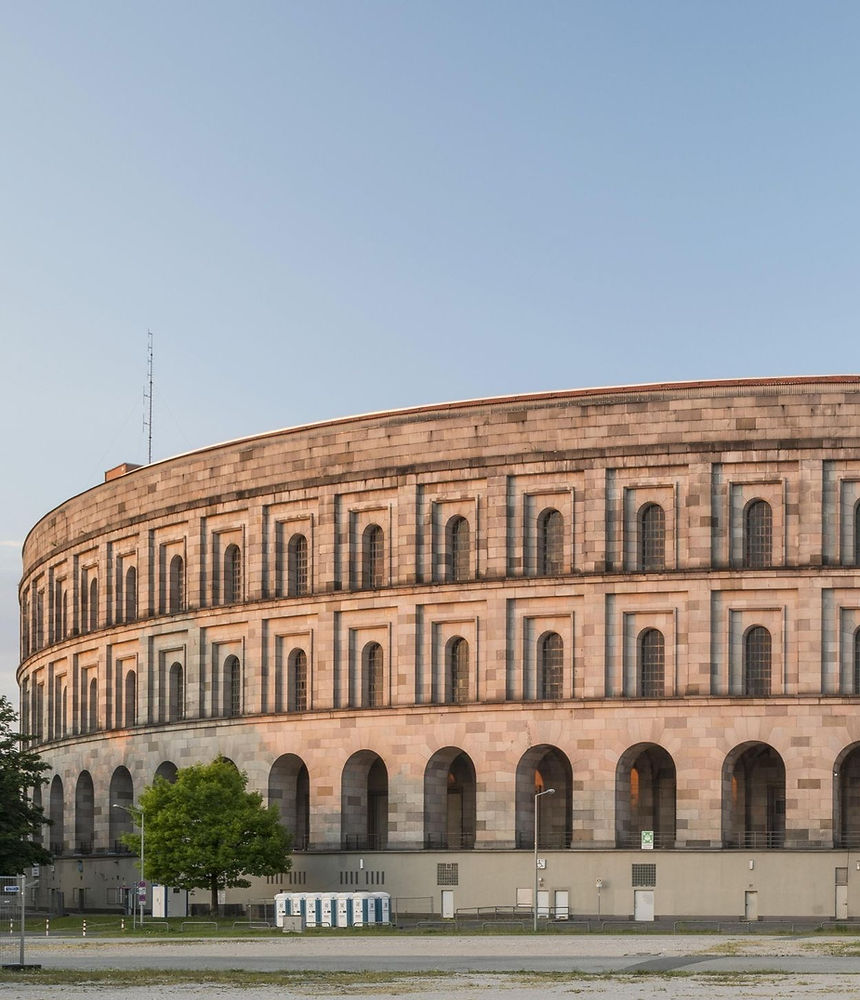
Nuremberg 3rd Reich Tour
Nazi rallys, WW2 and the Nuremberg trials
suggested tip 15 €

Nuremberg Beertasting (Deutsch/English)
Beertasting in Nuremberg
From 10€ per person

ALL OUR ENGLISH TOURS

ALL OUR GERMAN TOURS

Bamberg Bier und Brauereien (Deutsch)
Private tours.
You need a special tour for your company?
You want a beertasting for you and your friends?
You want a history tour for your students?
These and more: Ask for an offer!
WHAT WE'LL SEE ON OUR TOURS

Nuremberg has it all! Its 1000 year history ranges from emperors and castles to Renaissance's richness, World Wars and Nazi trials. We show you hidden alleys and famous monuments as well as the local cuisine. Nuremberg is easy to reach on trips from Munich, Passau, Bamberg, Würzburg or Regensburg, but is worth a journey on its own!
WHY YOU SHOULD JOIN US
Don't expect a normal city tour! Since 2016, on our Free Walking Tour you experience Nuremberg's old town with enthusiastic locals. In 2.5 hours, we offer you an entertaining mix of history, legends, fun facts and useful recommendations for the rest of your stay.
After the Free Tour, our private Third Reich Tour provide you with deeper insights to recent history and modern culture. A private tour with a private guide offers most flexibility for you and your group and the Bamberg Free Walking Tour suits perfect for a day trip from Nuremberg. The tours are suitable for all ages and can also be visited with a wheelchair, pram or dog. Everyone is welcome!
Free Tours and start at the "Schöner Brunnen" monument on Hauptmarkt (central market square) on the days and times as above . There is no reservation required, however we recommend you to sign in so we can keep you updated about the status of your tour. To all our tours we welcome you with our green and white umbrellas and a warm smile!

OUR PARTNERS
Please leave us a rating.


IMAGES
VIDEO
COMMENTS
A Walking Tour of Nuremberg (Nürnberg) is the best way to explore this delightful historical city in Bavaria. Discover half-timbered houses, many museums, the famous Nuremberg Trials and the home of Albrecht Dürer.
On this self-guided walking tour of Nuremberg’s Old Town, you’ll see all the highlights while also having the opportunity to stop at several places along the way to delve deeper into Nuremberg’s history.
Our Free Nuremberg walking tour map covering Old Town the city's and main squares up to Nürnberg. It is a do-it-yourself guided tour of Nuremberg Germany
If you are looking for the best things to do and see in Nuremberg during your visit, do a free tour with a local guide can be an option to know the essential places as well as history and culture through the most important streets of the city.
Find yourself immersed in Nuremberg‘s history, extending far beyond its well-known trials, on this walking tour through …. 30. From Munich: Nuremberg Old Town Private Day Trip. The impressive history of the 2nd-largest city in Bavaria is involving and full of interesting facts you should not miss….
Discover history, culture and food of Nuremberg and Bamberg on our regular free walking tours and private tours in Deutsch and English.